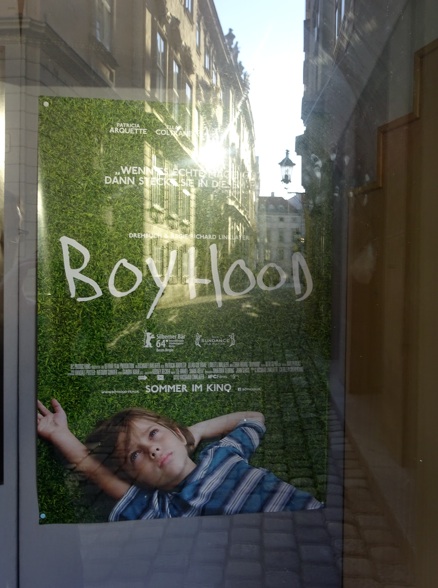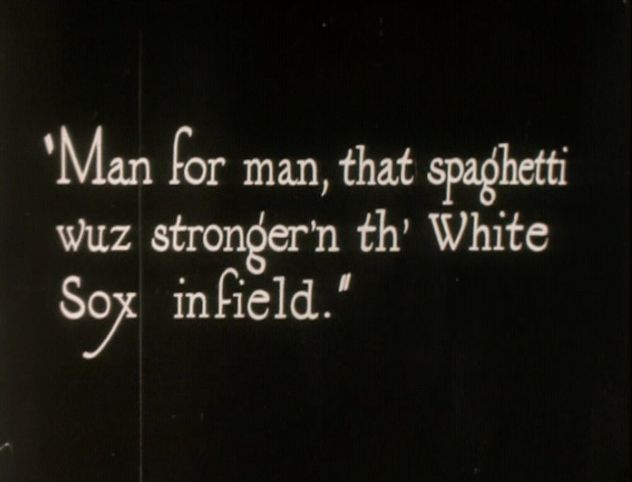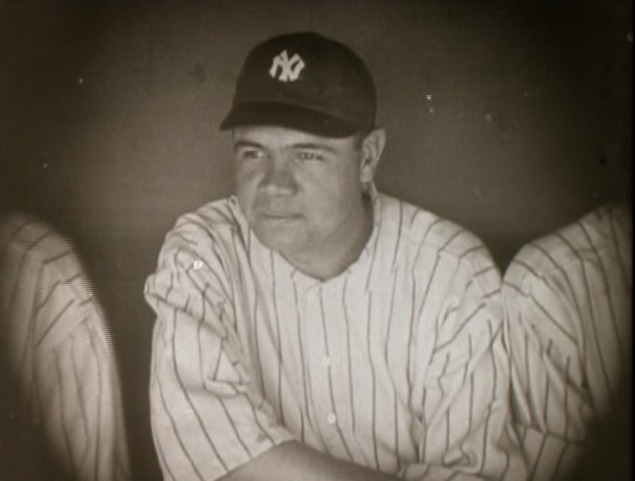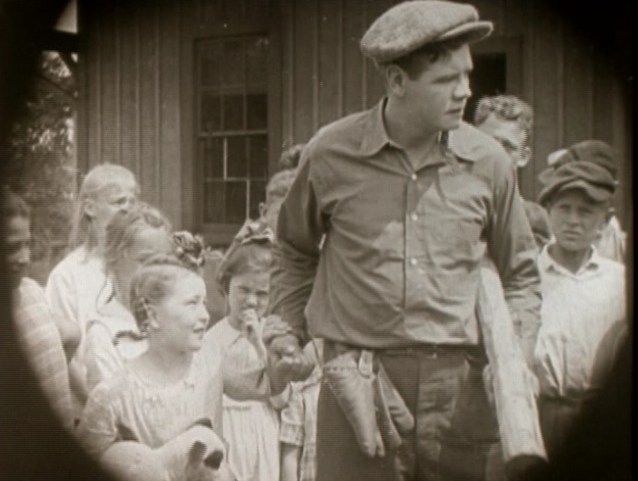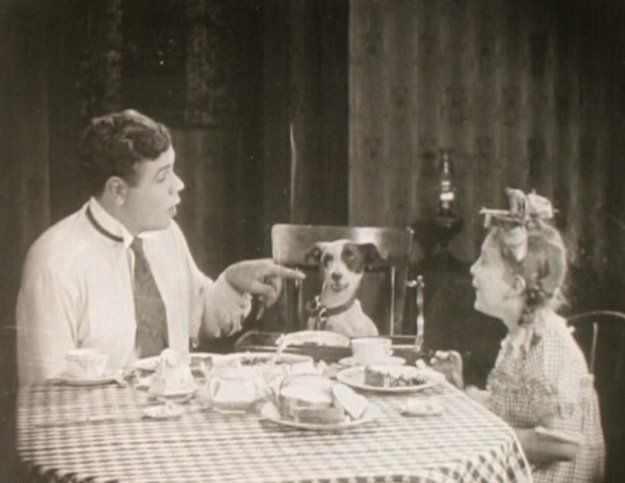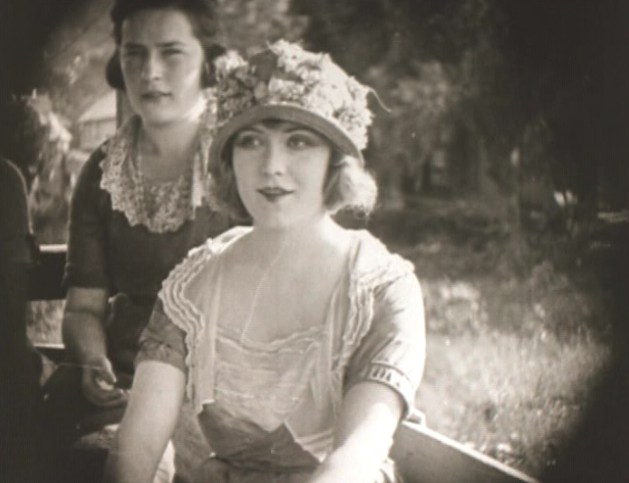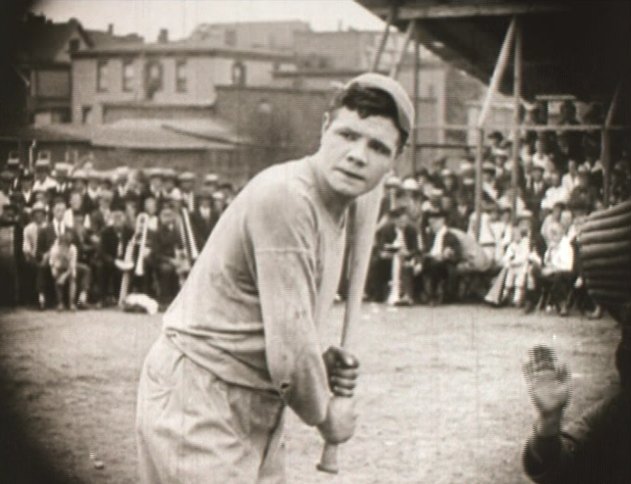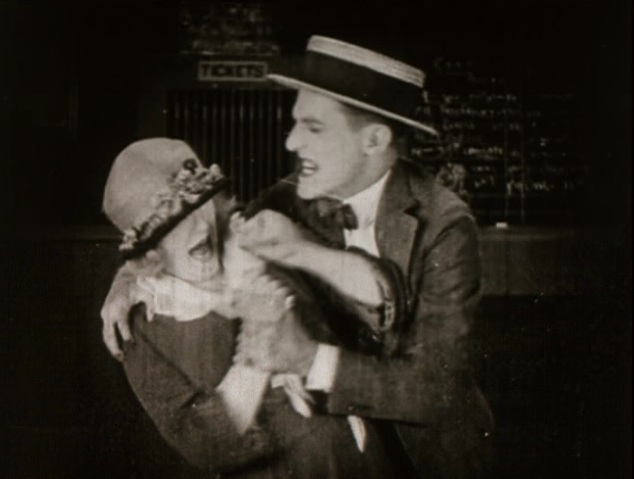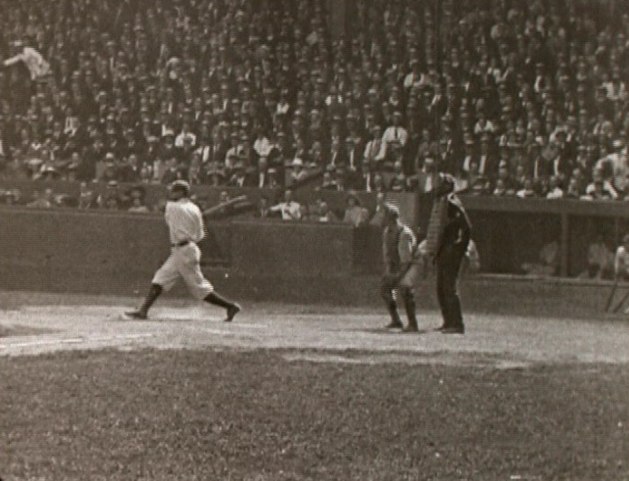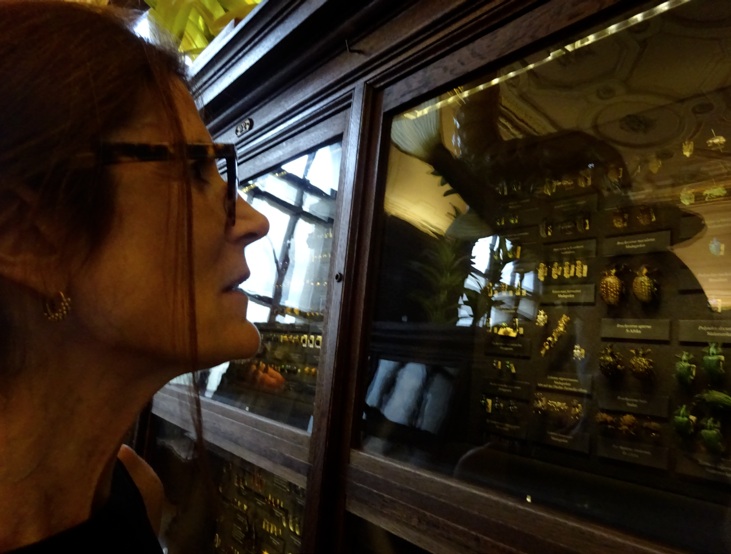Wednesday August 27, 2014
Movie Review: The Immigrant (2013)
WARNING: SPOILERS
I think of the word “traduced” when I think of this movie. As in: Someone must have traduced Ewa C., for without having done anything wrong she found herself in America one fine morning.
Marion Cotillard plays Ewa Cybulska, a Polish immigrant arriving in America in 1921 with her sister Magda (Angela Sarafyan), who is suffering from tuberculosis and thus taken out of line at Ellis Island and placed into quarantine. She disappears into the bowels of an uncaring, faceless bureaucracy. Ewa, meanwhile, is traduced: declared a woman of low morals because of a shipboard incident. But she is saved from disappearing into bureaucratic bowels by Bruno Weiss (Joaquin Phoenix), a man who insinuates himself into every situation and exudes ickiness from the get-go.  He declares he will vouch for her, does, and off they go into the uncaring bowels of New York City: the lower east side.
He declares he will vouch for her, does, and off they go into the uncaring bowels of New York City: the lower east side.
Bruno, it turns out (and big surprise), runs a kind of burlesque show. He’s half barker, half pimp, and our concern for Ewa is of a traditional nature: Will she be forced into prostitution? What of her virtue? Oh, what of it? My concern for the movie, meanwhile, was graver: Would this just be a sad, downward-trajectory film or would it veer in unexpected directions? Could it retain our interest and still feel true?
The good news is it’s not simply a downward-trajectory film. Ewa isn’t just a victim and Bruno isn’t just a victimizer; but the prostitution thing still happens. Off camera, mostly.
Unraveled, Ewa’s story is a sad one:
- Her parents were killed during the Great War.
- On the ship to America, she is raped, which is why she is declared “a woman of low morals.”
- Her uncle, who is supposed to meet her at the dock, abandons her when he discovers her new, traduced reputation. When she finds her way to his and his wife’s place in Brooklyn, he hands her over to the cops, who hand her back to Bruno. She’s trapped.
The arrival of Emil (Jeremy Renner), a Houdini wannabe, cousin to Bruno and rival for Ewa’s affections, adds energy and comedy to the story. Ultimately tragedy, too. The cousins fight over her and Emil is killed. For some reason that I can’t quite fathom, Ewa immediately becomes a suspect in his murder. It was Emil’s knife, they had been seen fighting publicly, yet somehow she is suspect. She could wind up in prison. Or worse.
It’s almost the Perils of Ewa. We’re just missing the traintracks.
Two wrongs, two rights
“The Immigrant” does two things wrong. One is that poster. Look at that thing. Who designed it? How incompetent do you have to be to make Marion Cotillard look both airbrushed and unattractive? You airbrush people to make them look more attractive, but she looks better in any frame of this film than she does in this lifeless thing. (Mouse over for a better version of the poster.)
The second thing the movie does wrong—and I hate to mention this because I’m a fan—is Joaquin Phoenix. He does not seem to be the man he’s supposed to be. He’s supposed to be slick but he’s not, a salesman but no, a user of women but how? Instead he gives us his usual, muddled, self-hating Joaquin schtick. This is a character who fended for himself as a kid on the lower east side? Since when?
But the movie also does two things right. First, it cast Marion Cotillard as Ewa. She’s a wonder to watch. She’s not only makes us feel this woman’s vulnerability, her toughness, her dedication to her sister, but she’s beautiful enough that you understand why both men fall in love with her. Yeah, I know: the movies are full of beautiful actresses. But ... Maybe it’s just me. We lust after actresses (Halle Berry, et al.), we get smitten by others (Carey Mulligan, et al.), but she’s the only one that makes my stomach do little flips. I get joy just out of watching her face. You know the line about how you’d pay to hear John Houseman read the phone book? I think I’d pay to watch Marion Cotillard read the phone book.
There’s also the film’s message of forgiveness. Throughout, Ewa is repulsed by Bruno; she despises him. But when she’s wanted for murder (which, of course, he committed), Bruno hides her. The cops beat him and he doesn’t talk. They steal everything he’s saved; ditto. Shortly thereafter, Ewa returns to her aunt’s home to ask for the money to free her sister. She asks this: “Is it a sin to want to survive when I have done so many bad things?” She says this. It’s like a break in the clouds:
God has sent me to someone so very lost, someone who made my life a sin. And now, this person suffers for me. So I am learning the power of forgiveness.
“The Immigrant” was written and directed by James Gray, who’s made, among others, “We Own the Night,” “Two Lovers,” and “The Yards.” Those are gritty, “good effort” movies. They’re trying for something and don’t quite get there. You want to like them more. This is another one.
Tuesday August 26, 2014
Lancelot Links
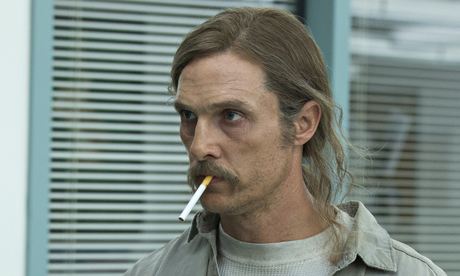
McConaughey as Det. Rust Cohle. “What do you think the average IQ of the Emmy voter is, huh?”
- Jay Leno at the Emmys: “And the winner is ... Modern Family!” Patricia: “Oh, for god's sake.” My feeling, too. And I love me some “Breaking Bad” but Matthew McConaughey was on another plane with “True Detective.” Nathaniel Rogers suggests some Emmy fixes, regardless of your rooting interests.
- A friend of a friend, under the nom de Twit “One Observation a Day,” offered up just that for 365 straight days. The year's done and here are the results.
- From Digital Music News, how the music industry has changed in one gif. The change refers to the thing we buy (vinyl, CD, download), not the music that's on the thing.
- I wrote my last movie review for The Seattle Times, on “Coach Carter,” in January 2005—I was moving to Minnneapolis—but I returned to their pages last Friday with a short review of “When the Game Stands Tall.” What do these movies have in common? Besides being about coaches and sports? They were both directed by Thomas Carter, Heywood on “The White Shadow,” and he didn't directed any feature films in between. Odd serendipity, no? Plus they're both not good.
- Have you been following Grantland's “Battle for the Best SNL Cast Member”? Have you been casting your votes? I have, nerd that I am. I really thought it would be Carvey vs. Myers in the “Lorne's Return” era (1986-1994) but it turned out to be Farley vs. Hartman. Here are my assumptions going forward: Murphy vs. Farley in the first 20 year bracket, Ferrell vs. Wiig in the second. The championship will be Murphy vs. Ferrell. Ferrell will win. And more cowbell will be heard throughout the land. But I've always been bad at prognositications.
- Why are the big-payroll teams losing so much this year? (Dodgers/Angels excepted.) Joe Posnanski thinks it ties to PEDs or their lack. He thinks it relates to what PEDs allowed players to do ... which they don't do anymore. M's fans take note. Spells doom, shortly. As I warned.
- You often hear things like “John Oliver explained that better than any journalist ever has!” But how often do you hear it from the Columbia Journalism Review?
- From the Onion: Judge orders pretty white girl will be tried as 300-lb. black man. Parody, but spot on. Father: “This is America: Nobody deserves to be treated as a black man!”
- The passing of a family friend. Rest in peace, Mark Saunders.
Tuesday August 26, 2014
Quote of the Day
“But here was a lesson Democrats would have all too much occasion to contemplate in the years ahead: to claim the mantle of purity is always a risky business. It just gives voters an excuse to be disillusioned once your ordinary humanity us exposed.”
-- Rick Perlstein on the Congressional class of 1974, the so-called “Watergate babies,” in his book, “The Invisible Bridge: The Fall of Nixon and the Rise of Reagan”
Tuesday August 26, 2014
Siskel, Ebert, and Top 10 Woodys
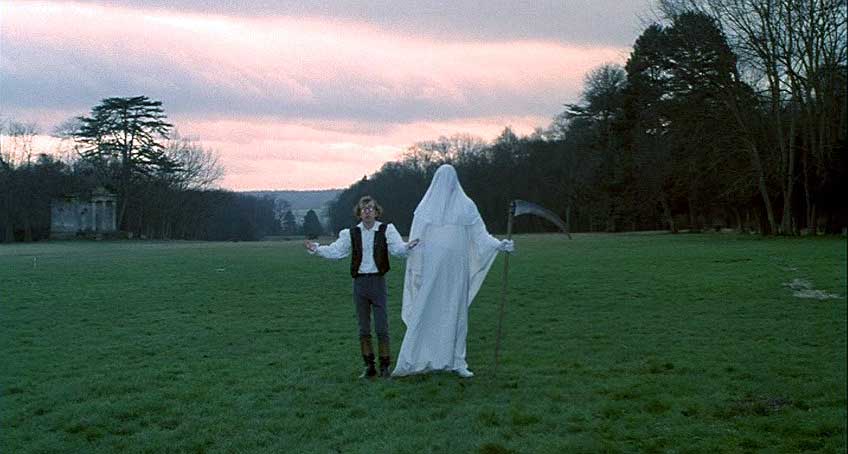
Woody Allen, with one of the title characters, in “Love and Death.” Gene Siskel recognized the genius before others.
At the end of the 1970s, Gene Siskel and Roger Ebert did a “Sneak Previews” episode arguing over who was the funnier filmmaker: Woody Allen or Mel Brooks. Siskel went Allen, Ebert went Brooks. I remember back then talking about it with my dad, the film critic for The Minneapolis Tribune. How could anyone choose Mel Brooks over Woody Allen? Sure he was funny, but ... Brooks has made only five movies in the ’70s, almost all parodies of film genres, and the last two, “Silent Movie” and “High Anxiety,” were hardly winners. Allen made a movie a year. He’d won two Academy Awards. His movie, “Annie Hall,” had won the Oscar for best picture. He kept growing. Plus I thought he was just funnier. Mel over Woody? Was Roger nuts?
“They probably flipped a coin,” my father said, “and Ebert lost.”
Looking over Siskel and Ebert’s annual top 10 lists recently, I see now that Siskel was in fact a bigger Allen fan than Ebert. “Annie Hall” was Siskel’s No. 1 movie of 1977. (No. 8 for Ebert.) “Manhattan” was No. 5 for Siskel in ’79. (It didn’t make Ebert’s list.) Siskel included “Annie Hall” among his best films of the decade and Ebert didn’t. Siskel included “The Purple Rose of Cairo” among his best films of 1985 and Ebert didn’t.
From 1975 to 1989, Woody Allen wrote and directed 14 movies, and half of them, seven, made Siskel’s annual top 10 list. My favorite inclusion is probably “Love and Death” as the third-best movie of 1975—ahead of “One Flew Over the Cuckoo’s Nest,” “Dog Day Afternoon,” “Barry Lyndon” and “Jaws." That’s still when Woody was doing broad comedy, too. But Gene always liked broad comedy.
Roger included five Allen movies during this period: Three at the end of the ‘80s—“Hannah and Her Sisters,” “Radio Days” and “Crimes and Misdemeanors”—and two from the ‘70s: “Annie Hall” and “Interiors.” Ebert would go on to include one more Allen movie on his top 10 list, “Everyone Says I Love You” from 1996, but Siskel’s list is almost the canon, isn’t it?
| Siskel's Top 10 Woodys | Ebert's Top 10 Woodys |
| Love and Death, 1975 (#3) | Annie Hall, 1977 (#8) |
| Annie Hall, 1977 (#1) | Interiors, 1978 (#6) |
| Manhattan, 1979 (#5) | Hannah and Her Sisters, 1986 (#3) |
| The Purple Rose of Cairo, 1985 (#10) | Radio Days, 1987 (#7) |
| Hannah and Her Sisters, 1986 (#1) | Crimes and Misdemeanors, 1989 (#8) |
| Radio Days, 1987 (#7) | Everyone Says I Love You, 1996 (#8) |
| Crimes and Misdemeanors, 1989 (#7) |
Anyway it's interesting to sort it all out this way. Might do more with other directors soon.
Monday August 25, 2014
Annette Lake, August 2014
P and I went on a hike with our friends Ben and Diana yesterday. This was our destination and lunch spot.
CLICK ON THE PHOTO FOR A BIGGER VERSION.
This is the third time I've hiked Annette Lake. It's not a bad hike, almost always under a canopy of trees so cooler than most, but hardly something to write a blog about. It's medium length (3 miles one way), without much elevation gain (1,000 feet or so), and fairly accessible: less than a mile from Exit 47 off of I-90. It's also not very crowded. The ending is pretty but hardly Snow Lake.
I think about it, though, because the first time I hiked it, in Sept. 2011, I was done almost before noon. It felt like child's play to me: too easy. I felt super strong. A month later I came down with what was diagnosed, a month later, as subacute thyroiditis. I've been in the wake of that ever since. Life gives and life takes, and this is one of the things it took. It'll take more.
Monday August 25, 2014
Hollywood B.O.: 'Guardians' Returns to No. 1; 'Sin City' Suffers for Its Many Sins
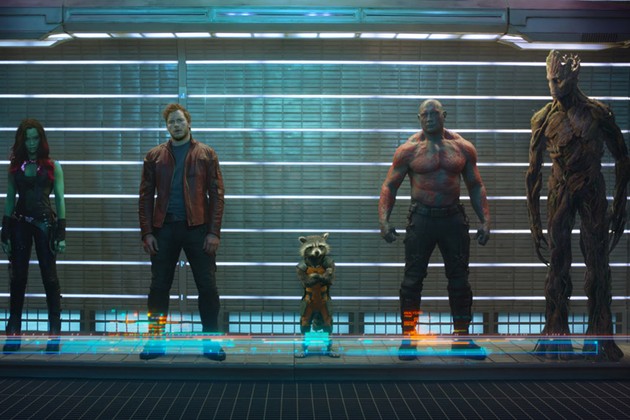
The good guys.
This is the kind of weekend box office that restores your faith in weekend box office. It’s a weekend straight out of a Hollywood movie: i.e., the good guys win, the bad guys get theirs, and some order is restored to the universe.
The good guys are “Guardians of the Galaxy,” which, in its fourth weekend of release, after two weekends at No. 2, returned to the No. 1 spot with another $17.6 million. In doing so, it surpassed “Transformers: Age of Extinction” (one of the bad guys) as the summer’s big hit with a domestic total of $251.8 million. And it will soon be the highest-grossing movie of the year, surpassing another good guy, “Captain America: The Winter Soldier,” which grossed $259.7 million in spring and early summer. Might “Guardians” reach $300 million now? It seems likely.
(What it won’t do is surpass “Transformers” as the highest-grossing 2014 film worldwide. Michael Bay’s robots have earned $1.065 billion around the world, way ahead of No. 2, “Maleficent” ($747.6 million) and more than twice as much as “Guardians” ($489.5 million), which has earned most of its money in the U.S. Effin’ foreigners.)
Meanwhile, “Frank Miller’s Sin City: A Dame to Kill For,” one of the worst movies of the year, got deservedly killed at the box office. It opened in 2,894 theaters but grossed only $6.4 million for 8th place. In April 2005, the first “Sin City” grossed $29 million (adjusted: $37 million) on its way to a $74 million domestic gross (adjusted: $94 million), so this is quite a comedown. Why? Most pundits are assuming:
- Nine years is too long between sequels.
- The comic book/pulpish style of its art direction, once innovative, is ho-hum now.
I might add :
- Frank Miller, in the interim, has revealed himself to be a reactionary asshole.
- The movie sucked.
Elsewhere, “Teenage Mutant Ninja Turtles” fell off 41% for $16.8 million and second place, “If I Stay,” Chloë Grace Moretz’s weepy teen flick, earned back its budget plus some with $16.3 million and third place, the second weekend of “Let’s Be Cops” made another $11 million for fourth, and the debut weekend of the Christian-football flick “When the Game Stands Tall” grossed $9 million for fifth place. I reviewed this last one for The Seattle Times. Here.
Finally, in limited release, Richard Linklater’s “Boyhood,” the best American movie of the year, lost 37 theaters but fell off only 6% for a $1.7 million haul. It’s now grossed $16.5 million. Have you seen it yet?
Saturday August 23, 2014
The Real Howard Beale
Throughout his book, “The Invisible Bridge: The Fall of Nixon and the Rise of Reagan,” author Rick Perlstein talks about how all elements of the culture, including movies, were influencing other elements, but he is more reticent in drawing lines (or bridges, invisible or otherwise) between specific political acts and subsequent films. Thus the way Nixon talked about POWs led to the notion that we still had MIA over there, which led, 10 years later, to the awfulness of “Rambo: First Blood Part II.”
Then there was this cultural tidbit about Christine Chubbuck that I don't remember ever hearing about:
Two weeks before the impeachment hearings, the perky hostess of the chat show Suncoast Digest, who incorporated homemade puppets into the program, was angry that the station owner had told the staff to concentrate on “blood and guts,” and had cut away from her show to cover a shoot-out at a local restaurant. She began her broadcast with an uncharacteristic hard-news segment, with film from the restaurant shooting—which jammed in the projector, at which point she announced, “In keeping with Channel 40’s policy of bringing the latest in blood and guts, and in living color, you are going to see another first—attempted suicide.” She then shot herself in the head and died, leaving behind the script she had been reading from, which included a postscript: a third-person account of the breaking news story, to be read by whomever took over the news desk next.
Yes, Virginia (or Florida), there really is (or was) a Howard Beale.

Saturday August 23, 2014
Movie Review: Sin City: A Dame to Kill For (2014)
WARNING: SPOILERS
“This rotten town soils everybody,” Nancy (Jessica Alba) says at the end of “Sin City: A Dame to Kill For.”
This rotten movie, too.
Is anyone still jazzed by this stuff? Does anyone think writer/co-director/creator Frank Miller isn’t a sad, sad man? Someone channeling Mickey Spillane through the Tobe Hooper grinder? A creepy, morally bankrupt, reactionary idiot?
His male characters still speak in sentence-fragment voiceovers:
Dwight: She’s playing it for all its worth. And it’s worth plenty.
His female characters are still argued about in the most infantile fashion:
Roark: She was a whore and not a very good one.
Johnny: She was an angel.
To recap: Sin City is a corrupt town where, if you’re a good man, you drink hard liquor every night, watch Nancy do her non-strip striptease, then go out and bust heads.  Preferably the heads of bad guys. You know: frat boys who light winos on fire or the hired bodyguards of the powerful and corrupt. You get to do what you want with these people because they’re bad. You get to torture people and feel moral about it. It’s like America after 9/11.
Preferably the heads of bad guys. You know: frat boys who light winos on fire or the hired bodyguards of the powerful and corrupt. You get to do what you want with these people because they’re bad. You get to torture people and feel moral about it. It’s like America after 9/11.
If you’re a good woman you’re most likely a prostitute. You wear lingerie and maybe a mask. Maybe it’s a Zorro mask. You tote a machine gun or a crossbow or a samurai blade, and you slice up the bad guys, often with the good guys by your side. And that’s about it for you.
Bad women are the ones who betray good men. Bad men are the ones with money and power. Innocent women are the ones who are killed by the bad men so we get another round of bloodletting by the good men.
Etc.
Worse than the first
The first “Sin City” (2005) was morally reprehensible but at least it kinda held together. At least the motivations and actions of its cartoonish figures kinda matched.
Here? Oy.
So Johnny (Joseph Gordon Levitt) is a lucky, coin-flipping son of a gun who decides to play poker with the most powerful man in the state, Senator Roark (Powers Boothe). Everyone warns him off. Everyone tells him you don’t beat Roark at poker and get away with it. But he does it anyway. Why? Because he’s one of Roark’s bastard children. Does he think this matters to Roark? It doesn’t. So he doesn’t get away with it. He’s beaten, shot, and his lucky hand is mangled, and his lucky charm, an innocent waitress named Marcie (Julia Garner), is killed. So he plots revenge. What is this revenge? He plays more poker with Roark, loses several hands (on purpose?), then wins big at the end. Then he tells Roark he’s a loser, and he’ll always know in his head that he’s a loser, because he, Johnny, beat him twice. Then Roark shoots Johnny in the head. That’s the end of that. Apparently revenge is a dish best smooshed into your own face.
In our second story, private dick Dwight (previously Clive Owen, now Josh Brolin) is revisited by the Love of his Life, Ava (Eva Green), the dame of the title. She’s watched over by a giant of a chauffeur, Manute (Dennis Haysbert), who is apparently the watchdog of her new, rich husband, Damien Lord (Marton Csokas). Is her husband holding her captive? Does he beat her? She implies as much. So after trying to rescue her and getting pummeled by Manute, Dwight returns with Sin City perennial Marv (Mickey Rourke), who relieves Manute of one of his eyes while Dwight relieves Damien Lord of his life. Except, ha ha, Ava is a femme fatale who is playing Dwight for a sap. She’s now a rich, powerful woman, and she sics the cops on Dwight, who holes up in Old Town with the lingerie-clad, sword-wielding prostitutes. Dwight spends this standoff getting plastic surgery, Ava spends it seducing the cop on the case (Christopher Meloni), who becomes so distraught he kills his friend (Jeremy Piven) and then himself. The point of this subplot? Who knows? Eventually Ava hires a Texas killer who turns out to be Dwight, post-plastic surgery, but everyone recognizes him. Then there’s a final big battle, with the lingerie-clad prostitutes vs. the hired bodyguards, and Ava is finally relieved of her life. And that’s the end of that.
Satisfied? Of course not. And it gets worse.
Worst for last
That’s the thing about “Sin City: A Dame to Die For.” Sex + violence isn’t supposed to equal boring but it does here. The violence is cartoonish, the sex puerile and voyeuristic. The dweebs it’s aimed at will probably find it boring. And Miller and co-director Robert Rodriguez save the worst for last.
So Nancy is the girl who was abducted by Roark’s pedophilic son in the first movie, only to be saved by Det. Hartigan (Bruce Willis), only to grow up to be the best stripper at the best dive bar in Sin City; and she, like Johnny, plots her revenge against Roark. At one point, dancing her cowgirl dance, she has Roark in her sights, but she can’t pull the trigger. Alas. So she has to drink, and emote, and dance some more raw, angry, sexually absurd dances, before she cuts up her own face and tells Marv that it was Roark who did it, which leads she and Marv to attack Roark’s fortress the way Dwight and Marv attacked the Lord fortress, and there’s another final showdown, this time between Nancy and Roark, the stripper and the Senator. But does she have the guts to finally go through with it? Moot point. He shoots first, her gun is inches away, and he’s about to take the final deadly shot when, in the mirror, he sees the ghost of Hartigan, who’s been following after Nancy for most of the movie, giving her bad advice she can’t hear; but his appearance here, in the mirror, gives her the time to grab her gun and blam blam blow away the baddest of the bad guys. After that, she visits Hartigan’s grave and says the last line and the lights come up and we all shuffle out of the theater feeling as soiled as Sin City.
Ick.
I’d want revenge on Frank Miller if I didn’t feel so sorry for the man. We get to leave Sin City after 100 minutes, but he invented it. He cared enough about it to put it on paper and then film. It will soil itself in his head forever.
Friday August 22, 2014
Movie Review: Divergent (2014)
WARNING: SPOILERS
So why doesn’t it work? Besides being monumentally stupid, I mean.
“The Hunger Games” (girl, dystopia, contests, remaining empathetic in an environment that fosters ruthlessness) opened in March 2012 and grossed more than $152 million in its first three days on its way to a $400 million domestic box office. Its 2013 sequel did even better: $424 million and the No. 1 movie of the year. This thing? Created on the heels of that? Another sweet/tough girl in a ruthless dystopia? It opened to $54 million and died. Its total domestic gross, $150.9 million, doesn’t even match the first three days of the other. Why? Besides this one being monumentally stupid, I mean.
Is it the lead? Shailene Woodley, bless her heart, is a helluva actress, and her face can crumple in pain like no one’s business, but she seems a little less sturdy than Jennifer Lawrence’s Katniss. 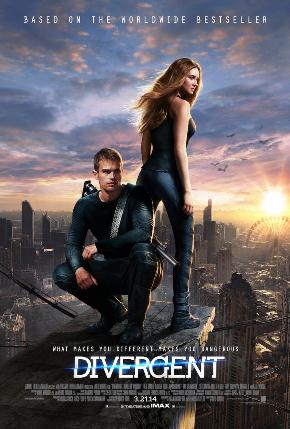 You buy J Law kicking ass and taking names. Shailene’s Beatrice, shortened to Tris, is all wide eyes and vulnerability. She can’t even punch a bag with any force. She’s no leader of an underground movement that will upset the balance of things.
You buy J Law kicking ass and taking names. Shailene’s Beatrice, shortened to Tris, is all wide eyes and vulnerability. She can’t even punch a bag with any force. She’s no leader of an underground movement that will upset the balance of things.
Is it the balance of things? In the beginning, we’re told there was a terrible war, and that the rest of the world was destroyed, but fortified cities like Chicago remain; and that the remnants of humanity were “divided into five groups, factions, to keep the peace.” Right. Because nothing keeps the peace like dividing humanity into separate groups.
Is it the groups? This is how humanity is divided:
- Erudite: “They know everything”
- Amity: Kind farmers
- Candor: The honest
- Dauntless: The brave and reckless
- Abnegation: Selfless
And who rules this dystopia? Abnegation, of course. You imagine the scene. “All of you dressed in gray? Who don’t care about yourselves? You’re in charge.” Not the thinkers, not the doers, and not the honest, who, here, are kind of like assholes. They’re like lawyers, aren’t they? Their symbol is the scales of justice. No matter. Abnegation rules. Because that’s how you keep the peace: divide the world into five groups and put the weakest people in charge.
Jumping off trains
So Beatrice starts out as Abnegation, like mom and pops (Ashley Judd and Tony Goldwyn), but she’s ... confused. She feels like there’s more to life than being just one thing. Sometimes she doesn’t know where she belongs. So it’s like high school. Or high school.
How do you wind up in a faction? At a certain age (18?), you take a test, which indicates which faction you belong to. But even after that, you still choose your faction at a blood-dripping ceremony. I never got this. What’s the point of the test if you still have to choose? And how many people choose something other than their test? And what does that indicate? And are they tracked by the authorities? Or is that not Abnegation’s way?
Moot point for Tris. When she wakes up from her test her test-taker (Maggie Q) is freaked. She tells her, “Your results were Abnegation ... and Erudite ... and Dauntless.” This is “extremely rare.” It’s called “divergent.” Don’t tell anyone.
So why did you just tell her?
What happens to divergents? They’re killed. To keep the peace. Because who needs someone who can unite factions?
Anyway, Beatrice now has to choose without a proper test, and for some reason—because she’d always admired them?—she drips blood onto Dauntless. And off she goes with Dauntless, who spend their days jumping off and on of el trains. Because Dauntless.
In her training, Beatrice reveals herself to be brave and smart (and selfless and honest), but she’s not that strong. There are contests, and she keeps losing, and is in danger of being drummed out of Dauntless and winding up with the wretched refuse that is the factionless. All of this takes place in Dauntless’ domain, which resembles a prison mixed with an archeological dig. She makes a few friends (Zoë Kravitz, formerly Candor), and a few enemies (Miles Teller, also formerly Candor). The trainers are Eric (Jai Courtney), a total asshole, and Four (Theo James), a kind of asshole but with nicer lips, so he becomes The Love Interest. He takes a subtle/not-so subtle shine to Tris. He’s also—third-act reveal—divergent himself.
Decking Kate Winslet
So what’s the story beyond the training? There’s an attempted coup, of course. Because some idiot put the weakest people in charge. I think that might’ve been author Veronica Roth. Who’s like 6 years old, according to Wikipedia.
After the training and the graduation, Tris and Four, together with mom and pops, work to prevent a coup by the sneakier elements of Erudite (Kate Winslet, working below her pay grade), and Dauntless (Meki Phifer, working at about his). Tris gets to punch Kate Winslet, and the rag-tag elements that prevent the coup take the el out of town and look into a sequel-filled future. That’s the studio’s plan anyway: this one, its sequel, and the final book cut into two movies to double the box office. What studios now call “The usual.” Moviegoers might have other ideas.
Pull back a moment. What does this story remind you of? This story: a few well-trained soldiers protecting the weak from evil, power-hungry thinkers? What is that?
It’s almost every movie ever made.
If Tris, or director Neil Burger, had only chosen Candor.
Thursday August 21, 2014
August 2014: MLB Division Leaders are Long-Time World Series Absentees
If you chose division winners based on how long it's been since they've been to the World Series, you'd get standings that looked like this:
| American League | National League |
| East: Baltimore Orioles (1983) |
East: Washington Nationals (never) |
| Central: Kansas City Royals (1985) |
Central: Chicago Cubs (1945) |
| West: Seattle Mariners (never) |
West: Los Angeles Dodgers (1988) |
As is, this is almost exactly what we have as the end of August approaches:
| American League | National League |
| East: Baltimore Orioles (1983) |
East: Washington Nationals (never) |
| Central: Kansas City Royals (1985) |
Central: Milwaukee Brewers (1982) |
| West: Los Angeles Angels (2002) |
West: Los Angeles Dodgers (1988) |
With the wild card race it gets a little messier. In the AL, you have Detroit, who last went two years ago, but also Oakland, which hasn't been since the Bash Brothers' year of 1990, and your Seattle Mariners, who have never been. In the NL, less promising: recent perennials St. Louis and San Francisco are the leaders. Only 2.5 games back from them, though, is Pittsburgh, which last went in 1979.
(Here's a list of teams and the last year they went to the World Series. Bump up both Boston and St. Louis to the top of the list: 2013.)
So we seemed destined, at the least, for something unique this fall. Instead of the same-old, same-old, we might get KC vs. Milwaukee, or Baltimore vs. Washington. Maybe the O's vs. the Dodgers? A rematch of '66?
Of course, my dream matchup would be the Seattle Mariners vs. the Washington Nationals. Think of it: Washington vs. Washington, east coast vs. west coast, the only two MLB teams who have never been to the World Series in a classic Series showdown.
OK, to be honest, my dream matchup would be Seattle vs. anybody.

Look, the matchup even stands for World Series.
Thursday August 21, 2014
'A Parody of a Parody of a Simple-Dick Noir Cartoon'
“I lasted about 45 minutes with Robert Rodriguez and Frank Miller‘s 'Sin City: A Dame to Kill For.' Not to sound pervy but I waited for Eva Green‘s nude scenes. Honestly? They were pretty damn good. That’s what this film is selling, right? Hard-boiled hard-ons. The first 'Sin City' (’05) was a simple-dick noir cartoon crammed with gruff machismo and brazenly sexual temptresses. 'Sin City: A Dame to Kill' For is a parody of a parody of a simple-dick noir cartoon ...”
-- Jeffrey Wells, “Candified Bird-Turd Noir,” on his Hollywood Elsewhere site. My review of the first “Sin City” here.

Green, Dawson, Alba: dames worth insulting your intelligence over?
Thursday August 21, 2014
Did Siskel and Ebert Agree More the Longer They Worked Together?
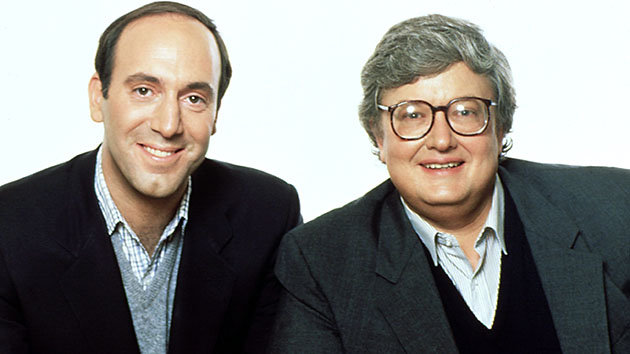
Siskel and Ebert: One liked “Apocalypse Now,” the other “Full Metal Jacket.”
One of the kicks I got out of the documentary “Life Itself,” on the life and times of film critic Roger Ebert, was watching Ebert and his TV partner/nemesis Gene Siskel battle over movies like Francis Ford Coppola’s “Apocalypse Now” (which Roger loved and Gene dismissed for its last, rambling 30 minutes) and Stanley Kubrick’s “Full Metal Jacket” (which Roger dismissed and Gene loved). These guys fought about Vietnam war movies the way the rest of the country fought about the Vietnam War.
All of which revived a thought I had as their various shows (“Sneak Previews,” etc.) wound their way through the years: Did Roger and Gene tend to agree more the longer they worked together? It seemed so to me at the time; but unless someone counted the thumbs ups/downs, we’d never really know.
Let me say right off: I’m not about to count the thumbs up/downs for 24 seasons of “Sneak Previews,” etc. No way. But I did compare and contrast Siskel and Ebert’s annual top 10 lists to see how they stacked up. Here are their number of top-10 agreements over the years:
| Year | 1 | 2 | 3 | 4 | 5 | 6 | 7 |
| 1975 | x | x | x | ||||
| 1976 | x | x | x | x | |||
| 1977 | x | x | x | x | |||
| 1978 | x | x | x | x | |||
| 1979 | x | x | x | x | x | x | x |
| 1980 | x | x | x | x | x | x | x |
| 1981 | x | x | x | x | |||
| 1982 | x | x | x | x | x | x | |
| 1983 | x | x | x | x | x | x | |
| 1984 | x | x | x | x | x | ||
| 1985 | x | x | x | x | x | ||
| 1986 | x | x | x | x | x | ||
| 1987 | x | x | x | x | x | x | |
| 1988 | x | x | x | ||||
| 1989 | x | x | x | x | x | x | |
| 1990 | x | x | x | ||||
| 1991 | x | x | x | x | |||
| 1992 | x | x | x | x | x | x | x |
| 1993 | x | x | x | x | x | x | |
| 1994 | x | x | x | x | |||
| 1995 | x | x | x | x | x | x | |
| 1996 | x | x | x | x | x | x | |
| 1997 | x | x | x | x | |||
| 1998 | x | x | x | x |
For a while there, as I was tabulating, it seemed like I was onto something. They start out with only three agreements in 1975 but within a few years they’re together on 7 of the 10. But then it slips. And rises? And slips. And then back down to three a few times. And we wind up with something fairly inconclusive.
Siskel and Ebert did seem to agree on the No. 1 movie of the year the longer they were together:
| Year | The Same No. 1 Movie |
| 1975 | Nashville |
| 1983 * | The Right Stuff |
| 1989 | Do the Right Thing |
| 1990 | Goodfellas |
| 1993 | Schindler's List |
| 1994 | Hoop Dreams |
| 1996 | Fargo |
* 1983 may have been their most agreeable year, since they were exact not only on No. 1, but No. 2 (“Terms of Endearment”), No. 4 (“Fanny and Alexander”), No. 7 (“Silkwood”) and No. 9 (“Risky Business”).
Their agreements are even starker with the best-of-the-decade lists. They agreed on only one movie as the best of the 1970s:
| The Decade (1970s) ** | |
| GENE SISKEL | ROGER EBERT |
| Last Tango in Paris | An Unmarried Woman |
| The Sorrow and the Pity | Apocalypse Now |
| Annie Hall | Amarcord |
| The Emigrants & The New Land | Breaking Away *** |
| The Godfather I & II | Nashville |
| The Conversation | Days of Heaven |
| Mean Streets | The Deer Hunter |
| The Last Detail | Heart of Glass |
| Saturday Night Fever | Cries and Whispers |
| Le Boucher | The Godfather I & II |
** Not in order of preference; simply in order presented.
*** Yes, I was tickled that this made Roger's cut.
But they agreed on four films in the 1980s:
| The Decade (1980s) | |
| GENE SISKEL | ROGER EBERT |
| 1. Raging Bull | 1. Raging Bull |
| 2. Shoah | 2. The Right Stuff |
| 3. The Right Stuff | 3. E.T. |
| 4. My Dinner with Andre | 4. Do The Right Thing |
| 5. Who Framed Roger Rabbit | 5. My Dinner with Andre |
| 6. Do The Right Thing | 6. Raiders of the Lost Ark |
| 7. Once Upon A Time In America (long version) | 7. Ran |
| 8. Moonlighting | 8. Mississippi Burning |
| 9. Sid and Nancy | 9. Platoon |
| 10. Kagemusha | 10. House of Games |
Fewer options, maybe? There were so many great movies in the 1970s, it was easier to disagree. I’ll take “The Conversation” and you take “Apocalypse Now”; you get “Days of Heaven” and I get “Mean Streets.” But in the ‘80s, if not “Raging Bull,” what? “The Return of the Jedi”? “Three Men and a Baby”?
(Sidenote: While “Raging Bull” is Roger’s best of the 1980s, it wasn’t even his best of 1980. He gave that one to “Black Stallion,” which, of course, didn’t make his decades-end list. Some movies just work on us better as time goes on.)
That said, overall, I wasn’t noticing statistically what I'd noticed anecdotally.
Then I realized that I was only documenting their time together. What about the years when they were both reviewing movies in Chicago but weren't doing the show yet? What story would that tell?
This is the story it tells:
| 1 | 2 | 3 | 4 | 5 | 6 | 7 | |
| 1969 | x | x | x | ||||
| 1970 | x | x | x | x | x | x | x |
| 1971 | x | x | x | x | x | x | |
| 1972 | x | x | x | x | x | ||
| 1973 | x | x | x | x | x | x | |
| 1974 | x | x | x | x | x | x | x |
In terms of top 10s anyway, they actually agreed more before they got together. From 1969 to 1974, they averaged 5.66 top-10 agreements. From 1975 to 1998: 4.95.
So I actually kind of proved the opposite of what I wanted to prove. I guess that’s why we crunch the numbers.
Wednesday August 20, 2014
Lancelot Links
- From McSweeney's: Classic movies changed to not be sexist. I think my favorite is “Gone with the Wind.” Maybe “Rear Window.”
- My colleague Sean Axmaker is leading a discussion at SIFF in November on Orson Welles' classic, “Touch of Evil.” Should be good. My thoughts on the film.
- Beginning in January, Major League Baseball has a new commissioner: Rob Manfred. Tyler Kepner wants to be more impressed.
- Did Billy Beane make a mistake trading Yoenis Cespedes for Jon Lester on July 31? John Branch looks at the A's subsequent dive.
- Julia Louis-Dreyfuss hocks her Emmy .. to Bryan Cranston and Aaron Paul. Love the supporting vs. lead/ comedy vs. drama discussions. But my favorite is JLD's look at 2:14 to 2:18. “It's sort of refreshing .... when they don't.” She's so, so good.
- A big biography of Bill Cosby, written by former Newsweek editor and FOP (Friend of Patricia) Mark Whitaker, is being published this fall. An excerpt.
- How the chief of police of Jonesboro, Ark., harassed a newspaper reporter out of her job.
- Guess what? That police chief didn't make friends in Americus, Ga., either.
- I'm no fan of Gov. Rick Perry but I get the feeling it's Special Prosecutor Michael McCrum who will be saying “Oops” over the indictment. On the other hand, according to the WSJ law blog, McCrum is admired by friends and colleagues.
- If you need to get caught up on Ferguson, the New York Times has provided a handy timeline.
- More from Jelani Cobb on Ferguson.
- And here's the private autopsy on Michael Brown: six shots, two to the head, none apparently at skirmish range.
- The editor in chief of RogerEbert.com, Matt Zoller Seitz, with a straightforward, personal account of understanding white privilege.
- I'm sure you heard the white, female CNN anchor who said of the cops at the Ferguson protests, “Why not perhaps use water cannons? At least it’s not going to have the same kind of effect [as tear gas].” What I like is the double-take of the black male anchor sitting next to her. Give the guy credit. He remains professional even as he can't help but be stunned by how little she knows of recent American history.
- Finally, Open Carry Texas is back, and this time they're black! The Huey P. Newton Gun Club is marching through South Dallas to protest the police killings. No word yet from the NRA on this development.
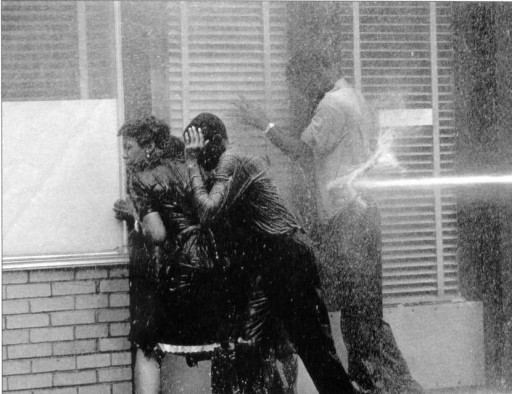
Birmingham, Ala., 1963. “Not the same kind of effect.”
Wednesday August 20, 2014
EuroTrip 2014: Where is The Third Man Museum?
We were only in Vienna two full days, and our last full day began poorly but ended well. After breakfast we started walking toward the Kunsthistorisches Museum but realized—again, standing by the Hofburg Palace—that it didn’t open for another hour. So what to do in the meantime? At this point it got a little “Marty”: “What do you wanna do?” “I don’t know, what do you wanna do?” P had done the research, knew what she wanted to see, I hadn’t and didn’t, and she was a little tired of leading the way. In the end, we decided to see something I wanted to see: Schreyvogelgasse 8. The doorway where Harry Lime first appears in Carol Reed’s “The Third Man.”
It took us to a part of town we hadn’t walked before—westish—where it felt less touristy. It felt like people were rushing to work rather than to museums. Along the way, P spotted a café with insane looking pastries, Café Central, but we’d just had breakfast so we simply made a mental note to return. We missed one block, then another, but eventually, clumsily, we found ourselves at the doorway. Was it the doorway? There was no plaque. It was just ... there.
P was also tired having her picture taken and never getting to take mine. So here she reversed it. Get in that doorway, she said. I obliged. I tried to do the Harry Lime look, the amused, amoral “Aren’t I clever?” look he gives Holly Martins after being discovered in the shadows. We tried once, twice, maybe 10 times. My eyes watered from the effort. That shit’s tough. Then we switched places and P didn’t try for the Lime look. She just owned the doorway. “One-take Patricia.”
Is there karmic serendipity in giving up what you want for what someone else wants? Early in their relationship, my sister left her job in D.C. to follow her then-boyfriend down to Atlanta, but got a better job as a result. A few years later, after they were married, she got an even better job offer in Detroit so he followed her there ... where he got a better job as a result. Something similar happened to us that morning. P went to the “Third Man” doorway for me, but found, half a block away, at Ludwig Reiter, the purse she’d been searching for all over Europe. The shop wasn’t open yet—when do the Viennese rise, anyway?—but she made a mental note to return. We left the area full of mental notes and digital photos.
We didn’t approach the doorway for the Kunsthistorisches Museum—across the plaza from yesterday’s Naturhistorisches Museum—until it was nearly 10:00, by which time a small line for tickets had formed. We got in it. And waited. And waited. And didn’t move. I got out of line to see what the hold-up was, and wound up conferring with another dude, a math professor from Brazil, both of us marveling at the remarkable inefficiency of the Austrians. Here we all were at the biggest art gallery in one of Europe’s biggest cities at the beginning of summer, and they had ... one ticket seller behind one glass booth? Really? In some ways it was comforting: a stereotype buster. Here was another: my guy from Brazil wasn’t particularly interested in the 2014 World Cup, which was still in its middle rounds at that point. Probably good for him in the long run, considering.
We spent several hours at the Kunsthistorische—P is all about the Dutch Masters—then had lunch, then split up again for the afternoon. She wanted to stay, I wanted to check out a museum to “The Third Man.”
My trip got muddled quickly. Most of the maps we had ended a few blocks south of the Ringstrasse, but the Third Man Museum was a few blocks south of that. Plus I got lost. Or misdirected. I convinced myself I was going in the wrong direction but wasn’t. I kept trodding over the same territory and felt the panic of missing out. P was seeing tons of art while I was wasting my time here! That panic of missing out, of not taking advantage of my surroundings, followed me, in varying degrees, throughout the vacation. To be honest, all vacations. It’s why it’s almost a relief when the vacation ends. You can get back to work and relax a bit.
To get to the Third Man Museum, I eventually realized, I had to cross over the Naschmarkt, with all of its goodies (“Patricia should really see this,” I thought), and the two busy streets on either side. Serendipitously, I wound up on Pressgasse, the street I needed to be on, and kept walking. A block later, after what seemed like hours walking around blind (it was probably a half hour at most), I finally spotted the museum on the corner of Pressgasse and Mühlgasse. It looked small and nondescript. It also didn’t look very busy. As I approached I had a sinking feeling in my stomach that was confirmed when I got close: “Closed.” The fuck? “Saturdays: 2-6 PM.” One day? It was only open one day? For four hours? Shouldn’t the guidebook have mentioned something like that? I rechecked it and found out it did—although it also mentioned Tuesdays. So instead of indulging in the bits and pieces of Carol Reed’s classic, I took a few pictures from the outside. In my head, I kept hearing Calloway’s dismissive advice to the idiot American abroad: Go home, Martins.
It took a while to find my way back to the Ringstrasse and the Kartnerstrasse, and once I did, and felt less tense (it was partly the hectic traffic outside the Ringstrasse), I wandered a bit, bought P macaroons at a small, snooty shop near our pension, then returned to our room and rested there for a moment. But there was no rest. The panic returned. In a day I wouldn’t be in Vienna! I was wasting my time! So I bounded out again—quickly, quickly—and visited Mozart’s residence on the other side of the Stephansdom. It wasn’t bad but it wasn’t great. Near the end, P phoned. She said she was on the other side of the Hofburg Palace and they weren’t letting anyone through because there were cops everywhere because Vladimir Putin was in town. Putin? I was missing out! I rushed over ... and found P on this side of the Hofburg Palace, on Kohlmarkt, not at all blocked off by the many cops there. She was just confused. She had a new purse with her, too, from Ludweig Reiter, which she loved, but less so the designer. He also made shoes and when she inquired if he had any in her size, size 11, his reaction was a dimissive laugh. “No,” he said, shaking his head, “we never have them in that size.”
For dinner, we went north, up the Rotenturmstrasse until we hit the Wien river, then along the river and up some steps to St. Rupert’s Church. This was a quiet area, and there seemed to be a few students around. Did I think that because of the name of the pub we stopped at for a drink? The Philosoph? It was the old Jewish section of town. It felt relaxing. For some reason, it’s a highlight in my memory. Sitting at the Philosoph, on Judengasse, enjoying a cold beer, an Ottakringer, in the magic-hour light before dinner. For a moment, I didn’t feel like I had to be anywhere else.
SLIDESHOW: WHERE IS THE THIRD MAN MUSEUM?
Tuesday August 19, 2014
Other Disasters Nixon Caused: 'Rambo: First Blood Part II'
“Operation Homecoming [in 1973] had returned 587 American prisoners of war—but for years Nixon had referred to 1,600 Americans being held in North Vietnam. That number folded in more than one thousand personnel, mostly pilots, who crashed in the dense Vietnamese brush and in previous wars would have been classed as 'Killed in Action/Body Not Recovered'—but had been reclassified as 'MIA' so the president could make the North Vietnamese look bad for his Paris negotiations. Now the families of those other 1,013 were making insistent noises: what was the government going to do about them?
”The Operation Homecoming statements by the Secretary of Defense and the Joint Chiefs of Staff included the promise that 'we will not rest until all those still known captive are safe and until we have achieved the best possible accounting for those missing in action.' Holding the government to that pledge had now become the raison d’être of the National League of Families of American Prisoners of War and Missing in Southeast Asia, the organization that had taken off as a White House front group. VIVA was still selling bracelets hand over fist—now bearing the names of MIAs. It had even come up with a new flag honoring them: a forlorn, gaunt, hangdog flat-topped silhouette, barbed wire and a guard tower in the background, a military laurel, and the legend POW-MIA: YOU ARE NOT FORGOTTEN ...
“It was one more aspect of the Americans' lunatic semiology that baffled hapless communist officials. 'We have not come this far,' one declared in exasperation at being once more enjoined to 'prove' they held no more prisoners, 'to hold on to a handful of Americans, after all what would that prove?' The issue was a godforsaken mess.”
-- from Rick Perlstein's “The Invisible Bridge: The Fall of Nixon and the Rise of Reagan”

Rambo and POW, about the be betrayed again. By government.
ADDENDUM: Started by Nixon, picked up by Reagan:
Governor Reagan, in Singapore as a special presidential representative for a trade deal, said North Vietnam must “return” the POWs and MIAs supposedly still being held, and that if it didn’t, “bombing should be resumed.” He accused liberals in Congress of taking away “the power to sway those monkeys over there to straighten up and follow through on the deal.”
Monday August 18, 2014
Movie Audiences Return ‘Giver,’ Find ‘Expendables' Expendable
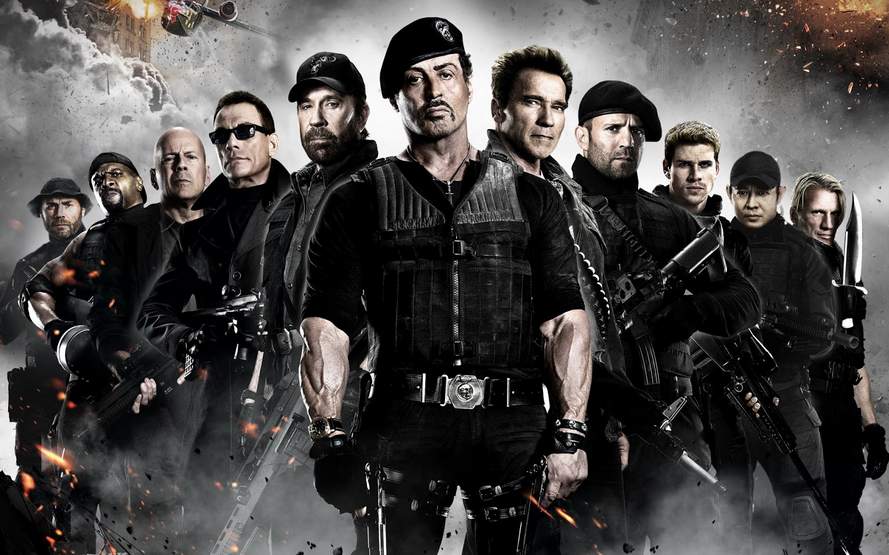
Expendable? Absolutely.
Someone needs to make a movie about all the dystopian Y.A. novels forced to battle each other in an arena for our pleasure and amusement. I guess we could set it in Hollywood, Cal., circa the futuristic world of, I don’t know, 2014. Call it ... “Sloppy Seconds”? “A.K.: After Katniss”? Title ideas welcome.
“The Giver,” based on a 1993 Y.A. novel by Lois Lowry, directed by Philip Noyce (“The Quiet American,” “Salt”), and with a cast that includes Meryl Streep, Jeff Bridges, Alexander Skarsgård and new Aussie Tiger Beat sensation Brenton Thawaites, opened in more than 3,000 theaters this weekend but grossed only $12.7 million. This follows the somewhat disappointing box office of “Divergent,” which opened in March and has grossed only $150 million domestic. Cf. the first “Hunger Games,” which grossed $408 million in 2012.
“The Expendables 3” grossed $16 million in 3,221 theaters, but that continues a downward trend. The first “Expendables” opened to $34.8 million in 2010, “The Expendables 2” to $28 million in 2012. Now this. Sylvester Stallone’s sexugenarian franchise keeps getting more and more muscle-bound and keeping dropping like a rock. Correlation?
“Let’s Be Cops,” the other big opener, grossed $17.7 million in 3,094 theaters, but that was still only good enough for third place.
First place was taken by the second weekend of “Teenage Mutant Ninja Turtles” ($28.4 million), while the third weekend of “Guardians of the Galaxy” was a close second with $24.4. “Guardians” has now grossed $222 million total. In a few weeks, it will probably be the highest-grossing movie of the year (currently: “Captain America,” $259 million), so kudos to its makers, for making it, and to us, for seeing it. It’s a fun ride.
Among indies, “Boyhood” grossed another $2 million and is now at $13.8 total. It’s Richard Linklater’s third-highest-grossing movie ever, after mainstream fare “School of Rock” ($81 million in 2003) and “Bad News Bears” ($32 million in 2005).
Friday August 15, 2014
Movie Review: Unforgiven (2013)
WARNING: SPOILERS
The most original thing about Lee Sang-il’s “Unforgiven,” which at times feels like a shot-for-shot remake of Clint Eastwood’s 1992 Oscar-winning western, is the character of Goro Sawada (Yuya Yagira), who is more dynamic and memorable than “The Schoefield Kid” (Jaimz Woolvett) in Eastwood’s version.
Unfortunately, Goro Sawada is completely reminiscent of an even more famous character: Toshiro Mifune’s Kikuchiyo from “Seven Samurai.”  He jumps, shouts, scratches his beard, and grunts similarly. And just as Kikuchiyo was with the samurai but of the farmers, having come from peasant stock himself, so Goro Sawada is with Jubei (Ken Watanabe) and Kingo Baba (Akira Emoto), former Samurai in the 13th year of the Meiji restoration, even if he is actually Ainu, a native of the island of Hokkaido, where the action takes place and the movie was filmed.
He jumps, shouts, scratches his beard, and grunts similarly. And just as Kikuchiyo was with the samurai but of the farmers, having come from peasant stock himself, so Goro Sawada is with Jubei (Ken Watanabe) and Kingo Baba (Akira Emoto), former Samurai in the 13th year of the Meiji restoration, even if he is actually Ainu, a native of the island of Hokkaido, where the action takes place and the movie was filmed.
It’s as if The Schofield Kid had been Native American. Which, to be honest, might have been an interesting choice.
There are other, subtle differences between the two movies, of course, including using the hero’s drinking less effectively. Plus the villain isn’t building a house as Hackman’s was. Instead of the end of the Civil War (1865) we get the end of the Shogunate (1868). We also lose—or lose in translation—some of my favorite lines: “Deserve’s got nothing to do with it,” and “We all got it coming, kid.”
Otherwise, it’s pretty much the same. A whore laughs at a dude’s penis, a whore is cut, a reward goes up. An aged hero and his aged sidekick decide to go for it. Before they get there, another man, a good samurai, tries, and gets his ass kicked. Our aged heroes are joined by a kid who doesn’t get it, arrive in a town that doesn’t want them, and the hero, sick with the flu, barely makes it out alive. Afterwards, he and the kid kill one of the guys who cut the whore, but his aged sidekick is captured and killed. Leading to ... You know.
So the big question with Lee Sang-il’s “Unforgiven” is: Why bother? I didn’t find an answer to that. Lee doesn’t improve upon Eastwood. Might as well remake “Seven Samurai.”
Oh, right. Well, there, too.
Thursday August 14, 2014
Quote of the Day
“I hope this volume might become a spur to renewing that debate in these years—a time that cries for reckoning once more, in a nation that has ever so adored its own innocence, and so dearly wishes to see itself as an exception to history.”
-- Rick Perlstein, in the introduction to his third volume of conservative history, “The Invisible Bridge: The Fall of Nixon and the Rise of Reagan.” Cf. this post from last year. Or this quote from James Baldwin. Read it a lot the last few days on my Kindle, which, at least in my version, gives you the percentage you've read rather than a page number. What did I see? 2%. Wish me luck!
Thursday August 14, 2014
Too Big to Care How It Looks
So I got a notice the other day from Chase. You know: Chase. I was supposed to read the notice carefully and retain it with my other important documents. It concerned by privacy. Or lack thereof. It began with this thought:
WHAT DOES CHASE DO WITH YOUR PERSONAL INFORMATION?
For some reason, this was in a chart labeled “FACTS,” when, you know, it's more of a question. But onward.
I assumed Chase was going to allay my fears about what it did with my personal information. Instead I got another chart:
| Reasons we can share your personal information | Does Chase Share? | Can you limit this sharing? |
| For our everyday business purposes —such as to process your transactions, maintain your account(s), respond to court orders and legal investigations, or report to credit bureaus | Yes | No |
| For our marketing purposes — to offer our products and services to you | Yes | No |
| For joint marketing with other financial companies | Yes | No |
| For our affilates' everyday business purposes — information about your transactions and experiences | Yes | No |
Those aren't really reasons, are they? Just like the other wasn't really facts. But onward.
They mention three other areas where they share my info—including “For non affiliates to market to you”—but apparently I can limit those. If I call. When I call. So we're not completely powerless. Just for all the above: everyday business purposes and marketing and joint marketing. But that's it. For now.
Anyway, nice notice. So nice to come home to.
Wednesday August 13, 2014
Quote of the Day
“People in Ferguson drifted out of their homes to witness the macabre spectacle of Brown’s body on the street, a dismal stream of blood winding its way across the asphalt. The ensuing vigil tipped over into bedlam as some in those crowds, joined by others, broke into sporadic vandalism and looting on Sunday night. Then, after dark on Monday, police responded with tear gas and rubber bullets. The ironies of race and policing were readily apparent: law enforcement using force to suppress outrage at law enforcement’s indiscriminate use of force. ...
”Three weeks ago, Eric Garner died as the result of N.Y.P.D. officers placing him in a choke hold, a banned tactic, following a confrontation over selling loose cigarettes. His death echoed that of Renisha McBride, the nineteen-year-old who was killed when she knocked on a stranger’s door following a car accident, which in turn conjured memories of Jonathan Ferrell, who was shot ten times and killed by officers in North Carolina soon after the death, in Florida, of Jordan Davis, shot by a man who wanted him to turn down his music, which in turn paralleled the circumstances of Trayvon Martin’s demise. For those who have no choice but to remember these matters, those names have been inducted into a grim roll call that includes Sean Bell, Oscar Grant, Amadou Diallo, and Eleanor Bumpurs.“
-- Jelani Cobb, ”The Anger in Ferguson," on The New Yorker site.
Wednesday August 13, 2014
Movie Review: Guardians of the Galaxy (2014)
WARNING: SPOILERS
We know how the roller coaster goes. Our heroes, misfits all, fight more with each other than with the bad guys, but eventually, through a series of adventures and misadventures, they abandon the more pungent aspects of their personalities for the greater good and come together for the final, big battle, with swirling dervishes going pew-pew-pew, and, somehow, against impossible odds ... win!
We know this going in. The roller coaster, being a roller coaster, can’t alter its tracks. So the question becomes: Do they make the ride fun?
Writer-director James Gunn (“The Specials,” “Super”), and writer Nicole Perlman (this), and some very talented cast members, led by Chris Pratt (“Parks and Recreation”), make Marvel’s “Guardians of the Galaxy” a lot of fun.
Who's BFF? (Before Fantastic Four)
It’s all about the characters, and these characters are fairly unique. Count ‘em off:
- Peter Quill (Pratt): Terran, outlaw, raconteur, who digs one-hit wonders of the 1970s.
- Drax (Dave Bautista): massively muscled and tattooed like a Maori warrior, he doesn’t understand metaphor; so he’s like the opposite of the Tamarians.
- Rocket (voice of Bradley Cooper): a raccoon bounty hunter ready to sink his teeth into any fight.
- Groot (voice of Vin Diesel): his companion, a calm, giant tree, who can only say three words and only in this order: “I am Groot.”
- Gamora (Zoe Saldana): a sexy, ass-kicking bad girl.
OK, so maybe we’ve seen Gamora before. Like all the time. And Quill is a bit like Han Solo with a better taste in girls and a worse one in music. Groot is the vegetation version of Chewbacca, while Rocket is, you know, a pint-sized Wolverine. 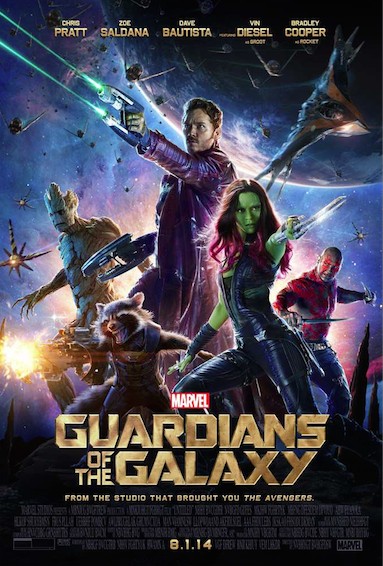 Sans cigar. Maybe they’re saving it for the sequel.
Sans cigar. Maybe they’re saving it for the sequel.
But they’re unique enough. Most of them came out of the trippy, 1970s-era Marvel comics universe, the long-haired, cosmic-looking, drug-taking wave after Stan and Jack. Jim Starlin gave us both Gamora (in 1975) and, with Mike Friedrich, Drax the Destroyer (in 1973). Rocket was Bill Mantlo and Keith Giffen’s 1976 homage to the Beatles’ “Rocky Raccoon,” while Steve Engelhart’s interest in astrology led to the creation of Peter Quill in 1976. Only Groot came earlier, pre-Silver Age, 1960. He was one of those “Tales to Astonish” outerspace villains forever imperiling earthlings in the days before the Fantastic Four: Droom and Rommbu and Vandoom and Moomba. Stan was big on the “oo.”
They are, in the comic book world, what they are here: misfits and castoffs and second- or third- or 39th-tier players. But they were put together in 2008 for the second iteration of Guardians, which first failed as a concept in 1969. And boom. Stars. Here, too. Basically they’re a funnier, less superhero-y version of The Avengers. But they’re fighting who the Avengers will soon fight. Spoiler alert.
Star-Lord, man
So one night in 1988, a boy, young Peter Quill, has a bummer of a night: 1) his mother dies, and 2) he’s abducted by a UFO. We next see him 26 years later on the planet Morag. By now he’s a rapscallion bounty hunter, who, like Indiana Jones, enters a cave in search of a precious object, but he doesn’t sweat it in the getting. The opposite. He kicks alien rodents out of the way while dancing to “Come and Get Your Love” by Redbone, from his AWESOME MIX TAPE, VOL. 1, which is a cassette of great one-hit AM-radio wonders of the ’70s his mom gave him. He even uses one rodent as a mic. It’s a mix of new technology (spaceships) and old (Walkman). Not to mention old tunes. It’s the fear of the unknown subverted. Remember the creepiness of alien worlds in the first season of “Star Trek”? Now it ain’t no big thang. Now squiggly creatures are just props for our pop cultural miasma. We’re humans from Earth.
As soon as Quill holds the orb in his hand, though, armed men, led by Korath (Djimon Hounsou), come to take it from him, and we set the tone for the rest of the movie:
Korath: Who are you?
Quill (in close-up and with gravitas): Star-Lord.
Korath (perplexed): WHO???
Quill (whiny): I’m Star-Lord, man. Legendary outlaw? Forget it.
I love this bit. A lot. He’s a kid playing a game forced to reveal he’s just a kid. He’s an adult with an inflated sense of self-worth forced to own up to the inflation. Quill is a semi-joke here, and we identify; but he’ll soon be, you know, the other thing. The hero. The One. Bummer.
It’s a busy universe he saunters through. There’s a truce between the Kree and Xander, but a Kree faction, led by Ronan (Lee Pace), is outraged and wants to wage war. The orb will help him do this. It’s got an infinity stone in it. Remember the infinity stone? I think it’s what Loki had in “The Avengers.” I think. Either way, it gives the holder incredible powers. What kind of powers? Incredible ones. Quit asking.
On Xander, Quill can’t unload the orb, and is then pursued by bounty hunters Rocket and Groot, even as Gamora, adopted daughter of the evil Thanos, wants him for herself. All four wind up in prison where they meet Drax, who joins their motley crew, such as it is, since he wants revenge on Ronan. They break out in a not-bad scene, then take the orb to The Collector (Benicio del Toro, channeling Karl Lagerfeld), while Quill tries to romance Gamora by getting her to dance. She says she doesn’t. Then this exchange:
Quill: Well, on my planet, we have a legend about people like you. It's called Footloose. And in it, a great hero named Kevin Bacon teaches an entire city full of people with sticks up their butts that, dancing, well, is the greatest thing there is.
Gamora: (thoughtful pause) Who put the sticks up their butts?
This is the reason the movie works for me: lines like these. In prison, for example, after Rocket explains to Quill that Drax takes everything literally, that metaphors go over his head, Drax is quietly affronted. “Nothing goes over my head,” he says. “My reflexes are too fast. I would catch it.” Does it help that writer-director Gunn (who also played Minute Man, as in My-NOOT Man, in “The Specials”) started out doing superhero parodies? Is that why they hired him? Either way, it was a smart move. Either way, this is a movie with smart people behind it.
“Star-Lord!” “Finally!”
Then it all becomes more roller coastery. Ronan, already powerful, gets the infinity stone and becomes super powerful, and he and his minions attack Xander, and pew-pew-pew! The Guardians try to stop him and save the universe. Face to face, Quill distracts Ronan with “O-O-H Child” by The Five Stairsteps and some decidedly post-1980s dance moves (anachronism alert), then Ronan gets shot and the infinity stone is up for grabs. Quill dives for it in slow motion. It’s his! But it almost destroys him. But on the verge of breaking apart, Gamora, then Drax, then Rocket, grab onto him, and together, as a team, they survive. And win. They also survive (and win) because Peter Quill is only half human. The other half is immortal or something. And in the end, he becomes the hero he always imagined himself to be.
That’s fine, I guess. I just like the whiny adult/kid bit better. I like the popping of his pretentions. Because we’re a culture ready to have a few of its pretensions popped now and again.
Tuesday August 12, 2014
Lauren Bacall: 1924-2014
I wrote the following for a piece on onscreen chemistry for MSNBC. I began talking about comic opposites and then landed here:
The genre where on-screen chemistry doesn’t require opposites is drama. Humphrey Bogart and Lauren Bacall, despite obvious differences (and viva those), sizzled in “To Have and Have Not,” in part, because her character, Slim, was as cool as Bogart, which is saying a lot. She plays a pickpocket who uses her sexual allure to separate men from their money. At one point she lands in his lap and kisses him, where we get this exchange before the more-famous exchange about whistling:
Bogart (smiling): What'd you do that for?
Bacall: Been wondering whether I'd like it.
Bogart: What's the decision?
Bacall: I don't know yet.
(She kisses him again; he kisses back; she stands up and smiles.)
Bacall: It's even better when you help.This may be the coolest woman ever to appear in movies ...
Haven't changed my mind on that. Here's the New York Times obit. Nathaniel Rogers counts down her 10 essential roles.
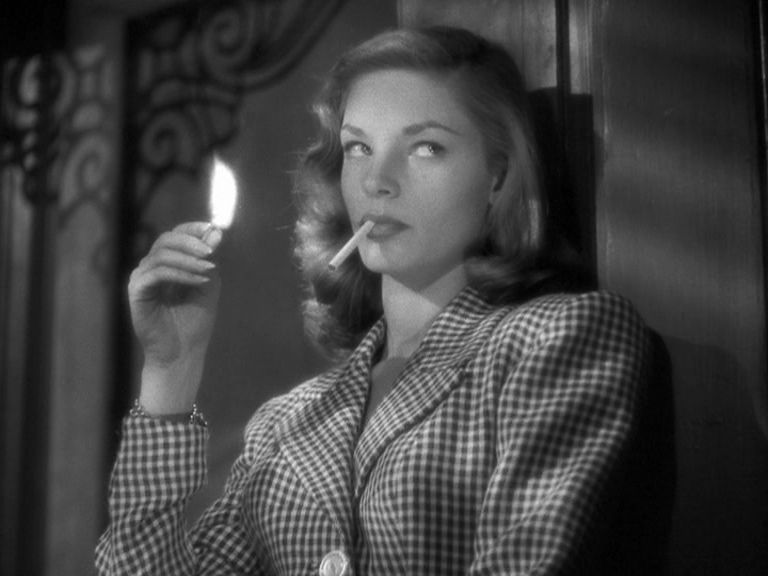
“It's even better when you help.”
Tuesday August 12, 2014
Lancelot Links
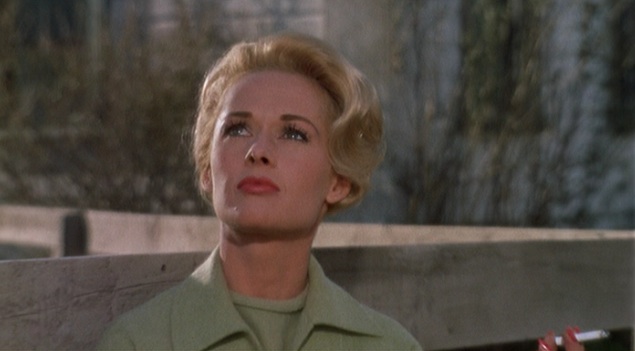
Kurosawa's fav Hitch
- In his memoir, “A Good Life,” Ben Bradlee recounts showing up for college baseball, hitting the dirt when the first pitch was coming straight for his head, then hearing the ump call it a strike. “That,” he writes, “was my introduction to the curve ball.” Alexei Ramirez? Meet Seattle's Yoervis Medina.
- Great foul ball moment.
- Do you have friends who think Adam Dunn is a Hall of Famer? You do? Ditch them immediately! Or have them read Joe Posnanski's latest.
- Artful Dodger Come Home? The Guardian reports on a cat that likes to ride the bus. Cue Replacements song. Or Jonathan Richman.
- A school lunch from 1943. 15 cents. I'm hungry already.
- Via Film Stage, here's a list of Akira Kurosawa's 100 favorite films. Chronologically. It starts with “Broken Blossoms” in 1919 and ends with “Han-Bi” in 1997. It's an eclectic, personal list. He limits himself to one film per director and his choices are .... interesting. His one John Ford film is “My Darling Clementine,” his one Hitchcock “The Birds,” his Scorsese “The King of Comedy,” his Kubrick “Barry Lyndon.” I don't think I've seen half the movies on it.
- My friend Jason has started a semi-annual screening series in Portland examining the issue of race in movies. It starts this fall and is called “Movies in Black & White.” You can follow the discussion on Twitter. Or show up in person.
- Prof. Justin Levitt of Loyola Law School has been tracking voter fraud allegations for years—not just prosecutions—and has found, since 2000, in all elections in the U.S., approximately 31 cases. Out of an estimated billion votes cast. And how many people are being turned away at the polls because of new voter ID laws? Thousands. Most of whom, one assumes, particularly based on the 31/1,000,000,000 number, are legitimate voters. The kind of fraud that voter ID laws are supposed to stop, he says, is very rare because it's extremely inefficient. Read about his findings in The Washington Post.
- Amy Davidson on the Michael Brown shooting in Ferguson, Mo.
- Roane County Circuit Judge Russell E. Simmons Jr. has upheld Tennessee's gay marriage ban. Some people just like to be on the wrong side of history. Or the wrong side of Ted Olson and David Boies.
- The New York Times Public Editor is back from vacation and finally weighs in the Perlstein/Shirley contretemps. Verdict? Oops. I particularly like Jeffrey Toobin's line. Actually I particularly like the notion that the Times may be revisiting its policy on he said/she said journalism—particularly if it's of the “Opinions differ on the shape of the planet” variety.
Tuesday August 12, 2014
‘Fly, Be Free’
This was from the pilot episode of “Mork & Mindy,” which my brother and I watched in September 1978. We laughed so hard.
Here are his biggest box office hits, adjusted for inflation:
| Movie | Studio | Adjusted gross | Unadjusted gross | Year | |
| 1 | Mrs. Doubtfire | Fox | $429,377,700 | $219,195,243 | 1993 |
| 2 | Aladdin | BV | $427,405,100 | $217,350,219 | 1992 |
| 3 | Night at the Museum | Fox | $301,889,000 | $250,863,268 | 2006 |
| 4 | Good Morning, Vietnam | BV | $245,778,800 | $123,922,370 | 1987 |
| 5 | Happy Feet | WB | $244,595,300 | $198,000,317 | 2006 |
| 6 | Good Will Hunting | Mira. | $240,561,300 | $138,433,435 | 1997 |
| 7 | Hook | TriS | $233,806,600 | $119,654,823 | 1991 |
| 8 | The Birdcage | MGM | $228,754,200 | $124,060,553 | 1996 |
| 9 | Patch Adams | Uni. | $222,823,900 | $135,026,902 | 1998 |
| 10 | Dead Poets Society | BV | $196,790,900 | $95,860,116 | 1989 |
Not a bad group. Even “Popeye,” his first film, directed by Robert Altman, which in my memory got confused reviews, confused box office, but became a cult hit among my slyer friends, even that movie grossed $150 million, adjusted.
Some remembrances:
- from Henry Winkler
- from A.O. Scott
- from Pres. Obama
- from Jeffrey Wells
- from Norm MacDonald
- Et al.
Fly. Be free.
Monday August 11, 2014
Movie Review: Get On Up (2014)
WARNING: SPOILERS
I’d read somewhere that “Get On Up,” the biopic of James Brown starring Chadwick Boseman (“42”), and directed by Tate Taylor (“The Help”), was a by-the-numbers biopic. That’s true only if numbers go like this: 101, 57, 4, 44, 6. The movie jumps around from 1988 and the bizarre circumstances surrounding Brown’s arrest in Albany, Ga.; to 1968 and his tour of Vietnam; to 1939, when his mother (Viola Davis) abandons him in the South Carolina woods; to 1964 and the disrespect of having some nothing band, the Rolling Somethings, close his show; then back to ’39/’40 again; then back to the '60s. Like Billy Pilgrim, it has come unstuck in time.
That’s unique for a biopic, which makes the opening all the odder. We hear a big crowd, people chanting and stomping, then see Brown in his later years walking backstage before a show. Sound familiar? Of course it does. Not only is it the beginning of almost every music biopic ever made, it was parodied to perfection in the otherwise disappointing satire, “Walk Hard.” “You’re gonna have to give him a moment, son,” Cox’s right-hand man tells the stage manager. “Dewey Cox needs to think about his entire life before he plays.”
Most music biopics are by-the-numbers in this way, too: hardscrabble beginnings, slow rise, white hot fame, drugs and/or overwork, fall, recovery, redemption, lessons learned. “Get On Up” starts this trajectory but veers sharply. The fall, such as it is, is caused more by hubris than drugs. And no lesson is really learned—certainly not by James Brown. In the end, he remains as imperious, and impervious, as ever.
Here’s a question: Does the movie consider him genius enough to justify this?
Boseman’s got the feeling
Kudos, by the way, to Chadwick Boseman. I think I first saw James Brown as parody—Eddie Murphy doing the celebrity hot tub bit on “Saturday Night Live”—and soon everyone was doing their version of Murphy doing James Brown.  How tough it must be to bring to life someone who’s been so caricatured; who is so easy to caricature. But Boseman does it. He does it, interestingly, not by showing us, say, a quieter, more complex side of the man (see Michael Mann’s “Ali”), but by pushing further intothe caricature. Brown was the imperious dervish onstage and off. He had a simple, blunt philosophy: Grab what you can, be what you are; there’s only you. Just don’t try to take the stage from him. Or his toilet. Or really anything of his. Or yours.
How tough it must be to bring to life someone who’s been so caricatured; who is so easy to caricature. But Boseman does it. He does it, interestingly, not by showing us, say, a quieter, more complex side of the man (see Michael Mann’s “Ali”), but by pushing further intothe caricature. Brown was the imperious dervish onstage and off. He had a simple, blunt philosophy: Grab what you can, be what you are; there’s only you. Just don’t try to take the stage from him. Or his toilet. Or really anything of his. Or yours.
I was less impressed with the role of Ben Bart, Brown’s first manager. “They’ve got to stop giving Dan Aykroyd these parts,” Patricia said as we left the theater. Indeed. He brings little. Aykroyd makes a word or two sound pungently New York/Jewish, as Bart was, before we’re back to a clipped Chicago sound. Was there no Jewish actor available? Jeff Goldblum? Mandy Patinkin? Mila Kunis? And what is the role exactly? Recognize Brown’s talent, give him a stage, and step back? Supposedly Bart came up with the idea of using kids to promote Brown’s concerts, saving the Godfather of Soul thousands if not millions in promotion fees, but the movie gives this idea to Brown himself. Supposedly when Bart died of a heart attack Brown couldn’t be bothered to attend the funeral, but in the movie version he’s so distraught he not only shovels dirt onto the casket but keeps doing it, bereft, sobbing, until he’s pulled away. Why? Why did this one man mean so much to him when most everyone else meant so little? And did Bart manage Brown’s money, too? Is that why Brown has back-tax issues, or did they arise only after Bart’s death? The movie makes it seem Bart was the wise counselor but we never get any of this wise counsel.
If I knew too much of the history in Boseman’s last film, I know too little of it here, and was often confused. Yvonne Fair (a scrumptious Tika Sumpter) shows up on the tour bus to catcalls from the band, shuts them down, and is then highlighted onstage as if in a silent battle with an audience member for Brown’s attention. Except Brown barely gives her a look. Question: Was the woman in the audience, Dee Dee (Jill Scott), already Mrs. James Brown or did that come later? Is this where they met? And if James never focused on Yvonne, why does the movie?
Super bad
The movie, to its credit, doesn’t ignore what an asshole Brown was. He’s beats Dee Dee, pushes and insults his band, undercuts his best friend Bobby Byrd (Nelsan Ellis, MLK in “The Help”). He’s a poor payer-backer. Byrd gets Brown out of prison, and sets him up with his band; but when the recording studio wants Brown alone, the Famous Flames, Byrd included, walk out. Brown lets them.
So when does Byrd return? Do we ever find out? One of the more vocal members of the next James Brown band, Maceo Parker (Craig Robinson), asks Byrd, late at night at a bar, why he puts up with Brown’s shit. The answer? Byrd recognizes Brown’s genius. In seeing what Brown is, he realizes what he lacks, and why he’ll never be the star onstage. He’s Salieri to Brown’s Mozart, but a benevolent Salieri to an even more ego-driven Mozart. This should have been the focus of the movie, to be honest, but the movie only makes it the focus at the end. Long estranged, Brown, without apology, visits Byrd at his home in ’93; then Byrd and his wife go to the show, the comeback show, where Brown stops the funk mid-beat and sings a beautiful old gospel number. As a gift for his old friend? As a final imperious send off?
“Get On Up” is a not-bad, better-than-I-thought-it-would-be, warts-and-all approach to a music biopic. I just got the feeling (baby baby) that Tate Taylor thinks James Brown’s warts are beautiful, too.
Sunday August 10, 2014
Quote of the Day
“Each year over 30,000 people die in the United States in firearm-related incidents. Many of those deaths involve handguns. The adoption of rules that will lessen the number of those incidents should be a matter of primary concern to both federal and state legislators.”
— Justice John Paul Stevens in his book, “Six Amendments: How and Why We Should Change the Constitution.” Chapter VI includes Justice Stevens' interpretation of the original meaning of the Second Amendment: “Concern that a national standing army might pose a threat to the security of the separate states.” He adds that for more than 200 years, “federal judges uniformly understood that the right protected by the text was lmited in two ways: first, it applied only to keeping and bearing arms for military purposes, and second, while it limited the power of the federal government, it did not pose any limit whatsoever on the power of states or local governments to regulate the ownership or use of firearms.”
Sunday August 10, 2014
Weekend Box Office: ‘Boyhood’ Pulls in Another $2 Million; Doofuses Waste $65 Million on ‘Teenage Mutant Ninja Turtles’
In his review of the reboot of “Teenage Mutant Ninja Turtles,” which opened in 3,845 theaters this weekend, Salon’s Andrew O’Hehir wrote the following:
I had to draw on my own ninja training and reflect intensively on the transitory nature of all phenomena, just to fend off the profound yearning for death.
O’Hehir better get used to dying because we’ll get more of these. Despite a 19% rating on Rotten Tomatoes, and the fact that the first reboot grossed only $54 million total in 2007, this rebooted “TMNT” led the weekend with a $65 million haul. It’s the 10th-best opening this year, and the 4th-best ever in August. Thanks, doofuses of America.
Other openers were all “meh” with the critics and the box office: “Into the Storm” drew a 21% rating and $18 million in 3,434 theaters; “Step Up: All In” (not to be confused with “Get On Up”) drew a 43% rating and $6.5 million in 2,072 theaters; and “The Hundred-Foot Journey,” continuing the reductive sunset-Brits-and-India theme with Helen Mirren, drew better reviews (64%) but so-so box office ($11 million in 2,023 theaters).
Last weekend’s No. 1, “Guardians of the Galaxy,” which has the advantage (one assumes) of a 92% critic rating and a 96% audience rating on RT, fell off only 56% for another $41 million. After 10 days, it’s slightly ahead of where the latest “Transformers” movie was: $175.9 vs. $175.3 million. But it seems unlikely to break the $300 million barrier. Which means we’ll have our first $300 million-less summer since 2001.
Whither “Transformers”? It keeled over with a bang. All the other Ts grossed at least $300 million, unadjusted, and at least $350 million, adjusted, while “Age of Extinction” won’t even reach $250 million. It’s stuck in the low 240s and grossed only $500K this weekend. Good riddance, I say. Or would say if it wasn’t killing overseas, where it’s grossed an additional $789 million for a worldwide total of $1.032 billion. Fourteenth-best all time. Thanks, doofuses of the world.
Among the smaller, indie releases, “A Most Wanted Man” grossed $2.2 million in 808 theaters for 12th place, while “Boyhood” grossed another $2 million in 507 theaters for 13th place. Haven’t seen the former yet but you should go see the latter. Because it’s the best movie of the year. And because somebody has to combat the doofuses.

Something to fight the doofuses with.
Saturday August 09, 2014
David Simon Uses the NY Yankees to Prove There is No God
David Simon, co-creator of “The Wire,” has an article in Sports Illustrated on his team, the Baltimore Orioles, and its chance of making the postseason this year. Any fan of any franchise that hasn't done well in, say, the last 30 years, will identify.
But this is the quote that had me nodding my head. Simon is writing about how the O's might win because anything can happen in an infinite universe. Then he asks, “How do we know this?”
Well, for one thing, there is no God. There is only science. If there were a God, he would be—as evidenced by all of modern baseball history—a devoted fan of the Yankees. And God, at least the Judeo-Christian version of Him rather than the Aristotelian unmoved mover, is said to be good. Ergo, there is no God.
Of course, Douglass Wallop had an alternative theory on Yankee domination.
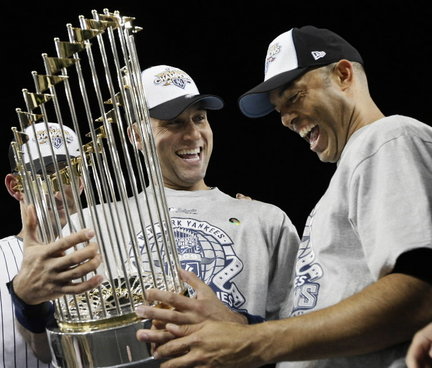
Jeter and Rivera celebrate another triumph in a godless universe, 2009.
Friday August 08, 2014
With Sylvia Kristel as Cordelia
“We want to do King Lear,” Golan announced proudly.
“Who are you going to get to play that,“ Caan asked, ”Chuck Norris?”
-- From an early 1980s conversation between actor James Caan and producer Menachem Golan, as the latter, with cousin Yoram Globus, tried to get the former to become involved in their fledgling studio, Cannon Films, famous, or infamous, for low-budget schlockfests starring the likes of Chuck Norris. Cannon Films would go on to ruin, among other movies, “Superman IV: The Quest for Peace.” and Captain America from 1990. Golan died today in his native Israel at the age of 85. The anecdote is via Nikki Finke's website.
Friday August 08, 2014
Frank Rich on Rick Perlstein on Ronald Reagan
Here's a key passage in Frank Rich's review of Rick Perlstein's much-anticipated third volume of modern conservative history, “The Invisible Bridge: The Fall of Nixon and the Rise of Reagan”:
The key to Reagan’s political success, in Perlstein’s telling, was that he recognized what many Republicans did not — that Americans craved “a liturgy of absolution” and “an almost official cult of optimism” postulating “the belief that America could do no wrong” or “that if America did it, it was by definition not wrong.” That’s why Reagan stubbornly insisted on minimizing the crimes of Watergate even though polls suggested he might be punished for it and even after most of his ideological soul mates jumped ship. That’s why Reagan never stopped insisting that we came home from our humiliating defeat in Vietnam “as winners.” He propped up such illusions by ignoring facts or inventing them. But the will of his listeners to believe — and his gift for making them feel good in his presence — conquered all.
Which ... yes. But what does that remind you of? Absolution and optimism? And, I would add, absolutism? And belief at the expense of truth? What industry is that? What city? What industry and city was Reagan steeped in, after all?
Why, Buddy, it's Hollywood. It's so-called liberal Hollywood, buddy.
For more on Reagan, Hollywood, optimism and innocence, see this.

It came from liberal Hollywood.
Friday August 08, 2014
Quote of the Day
“First, the outsize Republican idolatry of Reagan is explained in part by the fact that there’s no one else in their history of whom they can really approve. The Bushes are a bad memory for most, Ford was a non-entity and Nixon was Nixon. Eisenhower looks pretty good on most historical rankings, but he’s anathema to movement conservatives: Eisenhower Republicans were what are now called RINOs. Going back a century, and skipping some failures/nonentities, Theodore Roosevelt is problematic for related but different reasons. Going right back to the beginning,and skipping more nonentities and disappointments, some Repubs still try to claim the mantle of the “party of Lincoln” but that doesn’t pass the laugh test. As many others have observed, the “party of Jefferson Davis” is closer to the mark. So, they have little choice but to present Reagan as the savior of the nation.”
-- John Quigan, “Reagan and the Great Man in History.” I l I like his website, too: “Crooked Timber.”
Friday August 08, 2014
Movie Review: Life Itself (2014)
WARNING: SPOILERS
When do you finally give up? When they take your ability to move? When they take your speech, your jaw, your looks, your ability to eat and drink? When they leave you with a flap of yawning, scarred flesh below your upper jaw and send you back out into the world? For Roger Ebert, forever film critic for The Chicago Sun-Times, as Gene Siskel, his partner for more than two contentious decades on “Sneak Previews,” etc., is forever film critic for The Chicago Tribune, the answer is: none of the above. He took all of this and kept going. But near the end of “Life Itself,” or life itself, we find out what breaks a man even as willful as Roger Ebert.
It’s not a hagiography. It’s important to point that out. “He is a nice guy,” one of Roger’s bar buddies from the 1970s replies to the documentarian, before adding with a smile, “but he’s not that nice.”
And he’s not. He’s fiercely competitive, full of himself, at times shockingly humorless. He was a raconteur but was he a good listener?  He listened to the movies and then held forth about the movies. He was kind to kids, and young filmmakers whose work impressed him (Errol Morris, Ramin Bahrani, Ava Duvernay), and old filmmakers whose work impressed him (Martin Scorsese, Werner Herzog). I would argue he was too kind to black cinema, or almost any movie that starred black people, but the doc doesn’t get into that. If it did, it would most likely spin it positively: How Roger was a champion of black cinema. It would mention, as this article mentions, the movies that topped his year-end list: “The Color Purple” in 1985 (eh), “Do the Right Thing” in 1989 (yes), “Malcolm X” in 1992 (let me double-check), “Eve Bayou” in 1997 (haven’t seen it) and “Monster’s Ball” in 2001 (no). But it wouldn’t mention that he gave thumbs ups to, among others, “Cop and a Half,” for which Siskel reamed him, as well as Spike Lee’s worst movie, “She Hate Me.”
He listened to the movies and then held forth about the movies. He was kind to kids, and young filmmakers whose work impressed him (Errol Morris, Ramin Bahrani, Ava Duvernay), and old filmmakers whose work impressed him (Martin Scorsese, Werner Herzog). I would argue he was too kind to black cinema, or almost any movie that starred black people, but the doc doesn’t get into that. If it did, it would most likely spin it positively: How Roger was a champion of black cinema. It would mention, as this article mentions, the movies that topped his year-end list: “The Color Purple” in 1985 (eh), “Do the Right Thing” in 1989 (yes), “Malcolm X” in 1992 (let me double-check), “Eve Bayou” in 1997 (haven’t seen it) and “Monster’s Ball” in 2001 (no). But it wouldn’t mention that he gave thumbs ups to, among others, “Cop and a Half,” for which Siskel reamed him, as well as Spike Lee’s worst movie, “She Hate Me.”
Oddly, the doc also doesn’t mention how he and Siskel championed the Chicago-area documentary “Hoop Dreams,” which Roger listed as not only the best film of 1994 but the best film of the entire 1990s. Why not? A moment of humility. The director of that doc, Steve James, is the director of this doc.
Chicagoan
Most of the time anyway. There’s a great, early scene that, despite its subject matter, is pretty funny. It’s about five months before Roger’s death. He’s in his hospital room with his assistant Carol, his step daughter, a nurse, and off camera Steve makes a casual joke. Roger responds, in that Steve-Hawking-style voice software, “I do the jokes around here.” Then, despite being physically helpless, he talks up his lack of control in the way that control freaks so. Of the women in the room: “I do what they tell me to do.” When someone asks a question about the doc, he says, “Steve is the director.” Almost immediately, though, he starts giving direction. “Steve, shoot yourself in the mirror,” he says. Steve obliges. Why not? He knows a good moment when he sees it.
James’ doc is both tough and moving, straightforward and complicated. Its transitions are about perfect. It keeps giving us Roger’s life story before returning us to the hospital room, or the physical therapy room, or the painful trip home for two days before pneumonia forces him back to the hospital room.
He was a journalist before he was a movie critic. As a child he created the “Washington Street News” is his hometown of Urbana, Ill., and delivered it around his neighborhood. He was editor in chief of his high school and college newspapers and wrote moving accounts of the big issues of the day: the bombing of the 16th Street Baptist Church in Birmingham, Ala.; the assassination of JFK. He went to Chicago for grad school but wound up at the Sun-Times, the working class newspaper, and within five months was its movie critic. It wasn’t a coveted gig. Before Roger arrived, most journalists there wrote under the nom de plume Mae Tinee, or matinee, but his arrival was propitious. He was young and American movies were about to go through a decade-long youth movement: “Bonnie and Clyde,” “The Graduate,” “Easy Rider,” et al. The studio era had ended and the summer blockbuster era hadn’t yet begun; in this interregnum a variety of very good movies appeared.
He was a Chicagoan above all. He was both brash and earthy, a heavy drinker at the corner bar, O’Rourke’s, until he stopped for good in 1979. After his Pulitzer in ’75, he got offers from bigger cities with bigger newspapers—Ben Bradlee of The Washington Post in particular—but he turned them all down. His excuse? “I’m not going to learn new streets,” he said.
I heard more than read Roger, of course, but the reviews we get here (of “Bonnie and Clyde,” “Cries and Whispers”) are spot-on: personal but all-encompassing. They remind me of how unnecessarily mired in the details I get. Like here.
It takes Gene Siskel a while to arrive but when he does, he does it with a twinkle in his eye. They were opposites in many ways, not just physically but emotionally, but both thrived on competition, and neither was more competitive than with the other. I would’ve liked a rapid compendium of some of their thumbs ups/downs. Did Siskel truly dislike “Apocalypse Now”? It didn’t wind up on his top 10 list for 1979, though it topped Roger’s list. Did Roger really dismiss “Full Metal Jacket”? Same deal, but No. 2 for Siskel that year. They argued over Vietnam War movies the way the rest of the country argued over the Vietnam War. But the doc points out they argued over everything.
Their rise is interesting. They wound up in most markets except New York and L.A., which took a coastal attitude. Chicago? Really? One of the show’s producers said the studios went “from helping us, to hating us, to fearing us.” “Two thumbs up!” became the coin of the realm, and other critics blanched. Isn’t that simplistic? Reductive? Richard Schickel spouted off in “Film Comment” in 1991 but he shows up here as a talking head to own, or not, what he said.
But they used their power for good. Saving Errol Morris’ career alone would make it all worth it, but Martin Scorsese implies they helped save his life with an award they suggested and presented at the Toronto Film Festival in the mid-1980s. Then they trashed (deservedly) “The Color of Money.”
They died in opposite ways, too. Siskel was diagnosed with an inoperable brain tumor, told no one, not even Roger, and passed away quickly at the age of 53. A few years later, Roger was diagnosed with thyroid cancer but hung on for 10 years. He revealed his jawless face to the world on the cover of Esquire magazine in 2010. He made this doc with Steve James. He kept going.
Generating machines
So what finally stopped this willful man? Back in the hospital for pneumonia, he finally sounds defeated. “I’m finished,” he writes James. His hands are swollen so he can’t type, so he can’t write. Take away everything but that. But they took away that, too.
“Life Itself” is powerful, moving, funny, and often tough to watch. I felt trepidation every time we returned to the present and the flap of skin below the jaw. I also disagreed with the doc almost immediately. These are the first words we hear. It’s Roger:
We are who we are: where we were born, who we were born as, how we were raised. We’re kind of stuck inside that person, and the purpose of civilization and growth is to be able to reach out and empathize a little bit with other people. And for me, the movies are like a machine that generates empathy.
Empathy? To me, movies are like machines that generate wish fulfillment and fantasy. They generate dreams of power and glory. They allow us, for a few hours in the dark, and for a short time after we walk into the light, to pretend to be stronger and sexier and braver than we actually are. They lie to us at 24 frames a second.
But the above quote is true for the best movies anyway. It’s also true for this one. I’d give it two thumbs up if I could.
Thursday August 07, 2014
Lancelot Links
- In 1965, the Beatles played in the home of the Twins: Met Stadium in Bloomington, Minn. This past week, nearly 50 years ago today, one of them, Paul Somethingorother, returned to play in the home of the Twins: Target Field in downtown Minneapolis. Jim Walsh celebrates.
- Walsh, the Studs Terkel of Minneapolis, also walks around the stadium and talks to folks. He snaps the smiles.
- Speaking of: Did you know Ron Howard is directing a documentary about the Beatles' touring years? Roughly 1960-1966. I'm there.
- 30 authors on movie adaptations of their work. I like Burgess' line on “A Clockwork Orange” and of course Vidal's on “Myra Breckenridge. Annie's Proulx's comment is touching. Most are as you expect: good films are praised, bad films are trashed. Although no author (Burgess, Nabokov, King) seems to like Stanley Kubrick's translations.
- For more than a decade, Rick Perlstein has been writing a comprehensive history of the rise of right-wing conservatism in the United States (Goldwater to Reagan, basically), and now, as the third edition, ”The Invisible Bridge: the Fall of Nixon and the Rise of Reagan,“ is being published, he's being attacked by a few of those conservatives, who don't want a liberal like him anywhere near Reagan. Slate's Dave Wiegel breaks down the controversy. Would that my accusations of whomever I didn't like could make headlines.
- Paul Krugman also pushes back—not only against those conservatives, but against his own paper, the New York Times, which did it's usual he said/she said reporting on the matter. What did Krugman call it? ”'Opinions differ on shape of the planet' reporting." Brilliant.
- And here's the lawyer for Perlstein and Simon & Schuster, Elizabeth A. McNamara, responding to Shipley's lawyer.
- Sorry, Seattle: There will be more 8 p.m. parking meters. I hate these things. Not for the money but the inconvenience. But also for the money.
- Remember: the story isn't Ezequiel Carrera's great catch with the bases loaded in the Tiger-Yankees game earlier this week; it's Derek Jeter's reaction to the great catch. Because Jeter.

A whole lotta shaking goin' on.
Wednesday August 06, 2014
How Gender was Added to the 1964 Civil Rights Act
The New Yorker's Louis Menand, reviewing Clay Risen's “The Bill of the Century” and Todd Purnam's “An Idea Whose Time Has Come,” has a good article, “The Sex Amendment,” on how gender was added to Title VII of the 1964 Civil Rights Act and thus changed the world. It's less heroic than you might think. Would you believe it was added by an anti-union, pro-business Republican congressman from Virginia?
Menand also goes into the history of women and African Americans—specifically white women and African-American men—butting heads over who should go first through the doorway in the battle for equal rights. He quotes Frederick Douglass speaking at an American Equal Rights Association meeting in 1869 about how women should have the same urgency for equal rights when they're hunted down, lynched, etc. Susan B. Anthony then responded thus in favor of women's rights first:
If you will not give the whole loaf of suffrage to the entire people, give it to the most intelligent first. If intelligence, justice, and morality are to have precedence in the Government, let the question of woman be brought up first and that of the negro last.
Yeah: Susan B. Anthony. Which just goes to show that even if you're on the right side of history doesn't mean you're on the right side of all history.
Wednesday August 06, 2014
Movie Review: Non-Stop (2014)
WARNING: SPOILERS
I can’t imagine the Federal Air Marshal Service is too pleased with this movie. Its hero, Bill Marks (Liam Neeson), is an Air Marshal, but he’s also a chain-smoking, depressive alcoholic who hates to fly. Nice combo. We actually see him boozing it up before he gets on the plane (i.e., before he starts his job of protecting us), then he needs Julianne Moore to hold his hand during takeoff, then he smokes in the airplane bathroom. Twice. Plus he’s fairly bumbling and inept throughout. He’s bad, for example, at explaining pertinent information to his superiors. Like how there’s a bomb on board. Ten years earlier, he was a New York City cop but apparently got canned for incompetence. So of course the FAMS snapped him up. Because it’s only national security.
“Non-Stop” is such an odd movie. It does a few things right but so many overwhelming things wrong. Its plot doesn’t quite mesh. 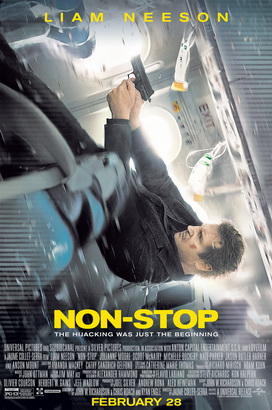 It keeps stretching its connective tissue until it snaps. It doesn’t know what year it is.
It keeps stretching its connective tissue until it snaps. It doesn’t know what year it is.
Here’s an example of not knowing what year it is. Halfway though the movie, Marks, identified as an Air Marshal, is trying to find a hijacker/terrorist on a flight over the Atlantic, but he gets no cooperation. From anyone. Almost every passenger on board isn’t worried about their safety; they’re worried about their civil rights. They keeps calling him a fascist and “Big Brother.” It’s as if it’s the 1960s. It’s as if they’d never seen planes flown into tall buildings.
J’accuse
OK, story. Shortly after the hand-holding takeoff, Marks starts getting taunting messages on his BlackBerry from another passenger about how unless $150 million is deposited in such-and-such an account someone on the plane will die every 20 minutes. So what does he do? Looks around a bit. Confers with a flight attendant. Confers with the other Air Marshal on board, a man named Hammond (Anson Mount). Then he kills him.
That’s not a bad bit, actually. Hammond, with debts, has been bribed into taking a briefcase full of cocaine onto the flight—we later discover there’s a bomb beneath all that powder—and he thinks Marks knows and freaks. I also like how he dies: In a fight in the close quarters of the airplane bathroom. Of course it’s been Hollywoodized. Neeson himself barely fits in an airplane bathroom; good luck getting someone else in there with him. (Ladies? Volunteers?)
But at least it’s interesting. The villain says someone on the plane will die every 20 minutes and the hero is responsible for the first death. He’s also responsible for the third. The second? Well, no. Instead, he accuses others of that murder. He keeps doing this: making enemies of allies. He’s unsubtle in his investigation. He blunders. He doesn’t tell the whole story when it would be so easy to tell the whole story. So people begin to suspect him—like his idiotic superior, Agent Marenick (Shea Whigham), who tells him the terrorist’s bank account is registered in Marks’ name. Ah ha! J’accuse!
One, why would Marks leave the bank account in his name? Two, if you suspect Marks of being that stupid, why would you be so stupid as to tell him?
At least there are a few suspects in the movie:
- Jen Summers, the redhead who wants the window seat, and who is perhaps too interested in what’s going on with Marks (Julianne Moore).
- The NY cop with a quick temper (Corey Stoll, who deserves better roles)
- The confused flight attendant from “Downton Abbey” (Michelle Dockery)
- The flight attendant from “12 Years a Slave” (Lupita Nyong’o), who is given nothing to do but be black and pretty
- The annoying black guy in first class (Zack White)
- The annoying black guy in coach (Corey Hawkins)
- The annoyed middle-aged white dude (Frank Deal)
- The skittish white dude who asked Marks for a light at the beginning of the movie (Scoot McNairy)
- The Muslim dude with a cellphone (Omar Metwally)
- The cute, scared girl (Quinn McColgan)
Right, not all are suspects. Not the girl, and not the Muslim dude (too obvious), and not the NY cop (too close to 9/11), although Stoll makes the man dick enough that I wondered. That’s what kept me going: wondering. Attempting to figure out who and why.
Ready?
The hijackers turn out to be the skittish white dude—the first suspected and discarded—and the annoying black guy from first class. They’re soldiers who signed up after 9/11 but were pushed off into a meaningless war, and they think our national security is a joke. Like Marks. The drunk. (Hammond goes unmentioned.) So they’re going to make it look like Marks hijacked the plane and killed everyone on board to wake up the U.S. government and its people to national security issues.
Hey, isn’t this a win-win for them? If they succeed, they’ve proven their point. If Marks stops them, as he does (spoiler alert), well, I guess they were wrong. The skittish white dude should’ve said this. He should’ve said, “Either way, I win.” But no.
Instead, Marks is simply the most put-upon Air Marshal ever. The passengers turn on him, his doofus superior relieves him of duty, and the media blares his villainy across the networks based on no information whatsoever. Then they exonerate him in two seconds after the plane crashlands in Reykjavik. It’s as if they’ve been watching the movie with us. Even Richard Jewell had to wait a few days.
Double Jeopardy
Director Jaume Collet-Serra also directed Neeson in “Unknown,” and this one suffers from some of the same problems. It wants to be a 1970s-style thriller but it also wants the heroic happy ending, and it’s tough to have both. Either Marks is a boozing, depressive incompetent ... or he’s the man we watch struggling against all odds for 90 minutes to save everyone. Put another way, the terrorists actually have a point. Marks really shouldn’t be an Air Marshal. Everyone was lucky to get out alive.
“Non-Stop” is basically another “‘Die Hard’ in a ...” movie—close quarters, hostages, indirect communication between hero and villain—but you know what I miss in these movies that the original “Die Hard” had? The hero taunting the villain. “Eeeh! Sorry Hans, wrong guess. Would you like to go for Double Jeopardy where the scores can really change?” Instead, we get the opposite: the criminal mastermind who is always three steps ahead of the hero, taunting the hero because of ... whatever. A personal grudge. No one has a sense of humor. About anything. What I wouldn’t give for a fly in the ointment, a monkey in the wrench, a pain in the ass.
Tuesday August 05, 2014
Quote of the Day
“All contributions by corporations to any political committee for any political purpose should be forbidden by law; directors should not be permitted to use stockholders' money for such purposes; and, moreover, a prohibition of this kind would be, as far as it went, an effective method of stopping the evils aimed at in corrupt practices acts.”
— Pres. Teddy Roosevelt, in his annual message to Congress, 1905, as relayed in Justice John Paul Stevens' book, “Six Amendments.” One of six amendments to the U.S. Constitution Stevens is arguing for would limit the kind of corporate spending in politics that the Ciitzens United decision unleashed.
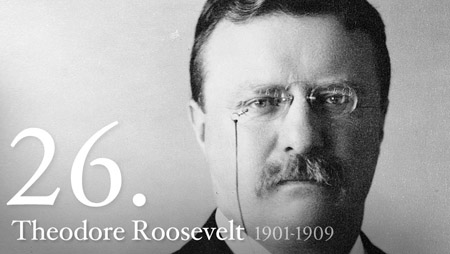
Tuesday August 05, 2014
Did Jeffrey Toobin Let Ted Cruz Lie About Prop 8?
There was an excellent profile of Sen. Ted Cruz (R-TX) by Jeffrey Toobin in The New Yorker last month: “The Absolutist.” You should check it out. You get a real sense of Cruz's history (his father fled Cuba before Castro), and why he is the way he is (conservative father and indoctrination into constitutional issues at the Free Enterprise Institute at the age of 12), and why he is formidable (national debate champion, “...on his way to becoming one of the most notable appellate advocates in the country”), and just how young he is (too young to have voted for Reagan).
All of that is good and worthwhile. But then Toobin ends the piece with a Cruz quote:
“Since I became a senator, a year and a half ago, I’ve kept two promises to the people of Texas. I have endeavored to do what I said I was going to do and I have always told the truth. It says something about Washington that those are perceived as radical acts.”
I have always told the truth. Yet earlier in the piece we get this quote from a speech Cruz gave at the 2014 Texas Republican Convention in Ft. Worth:
“Marriage is under assault,” Cruz told the crowd. “It is under assault in a way that is pervasive. We’re seeing marriage under assault in the courts, including, sadly, the Supreme Court of the United States. It struck down the California marriage laws. California had a referendum. They asked the voters of California, ‘Do you want marriage to be a traditional marriage between one man and one woman?’ And the voters of California—those crazy right-wing kooks—said, ‘Yes, now that you mention it, we like marriage to be between one man and one woman!’ Went to the U.S. Supreme Court, and the U.S. Supreme Court said, ‘You can’t say that,’ and struck it down. You want to know what judicial activism is? Judicial activism is judges imposing their policy preferences on the words of the Constitution.”
I'm no national debate champion, let alone one of the most notable appellate lawyers in the country, but I know Cruz isn't telling the truth here. Because he knows the U.S. Supreme Court did not “strike down” California marriage laws. Here's what happened.
The voters of California passed Prop 8 by a 52-48% margin. Two years later, the federal district court in San Francisco overturned it, declaring Prop 8 unconstitutional under the due process clause. The state chose not to appeal, but others did: the initiative's proponents, along with Imperial County. After various judicial perambulations, the case wound up before the U.S. Supreme Court in 2013, which ruled, 5-4, that those who brought the appeal (Prop 8's proponents and Imperial County) did not have legal standing to bring the appeal. Case dismissed.
The U.S. Supreme Court struck down California marriage laws? It didn't rule on California marriage laws.
This might seem like semantics to most people but I can guarantee you one of those people would not be “one of the most notable appellate advocates in the country.” Cruz said what he said, fudged the truth of what he said, because he wanted red meat for the Texas crowd to sink its teeth into. He was being a politician. He was being a D.C. insider. He was not telling the truth.

Ted Cruz gave at the 2014 Texas Republican Convention:offering red meat at the expense of truth.
Monday August 04, 2014
Quote of the Day
“Just one year ago, Republicans were talking about passing their own version of the DREAM Act. Tonight, they put the party on record for the total cessation of Barack Obama’s quasi-DREAM Act. The arc of history is long, but it bends toward Steve King.”
-- David Wiegel, Slate, “Republicans Finally Pass a Border Bill: So What's In It?” on the 11th-hour House bill, which offers 1/5 of the resources that Pres. Obama requested, along with deportation of the half a million DREAM Act kids, to address the child migrant issue. Andrew Sullivan adds, “It won’t pass the Senate, of course, but it gives House Republicans a Potemkin vote they can cite when they face their Hannityed constituents this month.” Ick ick ick.
Monday August 04, 2014
Gun Control Symbol Dies
Is this a resonant headline or what? Sadly so.
“Gun Control Symbol Dies.” Apparently in Alexandria, Va., too, and not in committee.
Brady, of course, was press secretary to Pres. Reagan, when, in March 1981, John W. Hinkley fired on the president and his entourage outside a Washington, D.C. hotel. One of the stray bullets entered Mr. Brady's brain. For the rest of his life, his left arm was paralyzed, his left leg weak, and he suffered short-term memory loss.
"What I was, I am not now,” he said in 1994. “What I was, I will never be again.”
As a result, he became a gun control advocate, and lent his name to the Brady Act, an amendment to The Gun Control Act of 1968, which Congress passed in 1993—the year before the Gingrich midterms turned everything bad. Five years later, the brunt of the Brady Act was struck down by the U.S. Supreme Court. In Printz v. United States, the 5-4 majority ruled that it was unconstitutional for the federal government to demand the assistance of local government officials in creating a national handgun database. However, the database was created anyway, as local officials didn't mind complying with federal requests.
The New York Times obit is here.
Monday August 04, 2014
Movie Review: Snowpiercer (2014)
WARNING: SPOILERS
Nice casting.
It’s a gritty, gray, dystopian future, right, and we need someone to play the saddled architect of the revolution. So why not the actor who played Winston Smith, the most saddled character from the greatest dystopian story of all, “1984”? Welcome, John Hurt.
And to lead the revolution? Why not Captain America? Nice to see you, Chris Evans.
And as the overconfident, grand manipulator of this mad dreamscape? Why not Ed Harris, the overconfident, grand manipulator of “The Truman Show”?
Welcome, all. And actors? Know your place.
Nice going, scientists
Quick question: What’s the most unthinkable thing that happens in “Snowpiercer”? That we inadvertently cause another Ice Age? 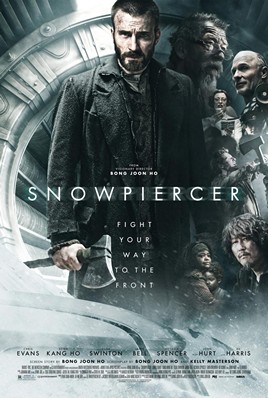 That the remnants of humanity are forced onto a train that is divided not only into cars but classes, with the majority, dirty-faced and Dickensian, stuffed into the tail section without rights, or, for a time, food? So that they are forced to eat the weak? Including babies?
That the remnants of humanity are forced onto a train that is divided not only into cars but classes, with the majority, dirty-faced and Dickensian, stuffed into the tail section without rights, or, for a time, food? So that they are forced to eat the weak? Including babies?
No. The most unthinkable thing that happens in “Snowpiercer” is that somehow humanity gets together and enacts a scientific solution to global warming this year. That’s optimistic. May I introduce Korean director Bong Joon-ho (“The Host,” “Mother”) to our do-nothing GOP-led U.S. Congress? Most of those guys don’t even believe in global warming. Or say they don't for monetary reasons.
But in the movie, sure, we do it. We all get together and seed the clouds with CW-7 to counteract global warming. And ... oops. Instead of a slight correction we plunge the Earth into a new Ice Age, during which everything on the planet dies. Nice going, scientists. The only ones left are the people on the supertrain. Is it called the Snowpiercer? Either way, it was started by a man named Wilford before the whole CW-7 experiment as a self-sustaining, global train ride, and now, 17 years later, it’s our last, best hope. But of course it’s been turned into an awful, dystopian nightmare: haves and have nots. A metaphor for our time.
We begin in the tail section, where armed cops show up and count off the rabble. Once your row is called you’re supposed to take a knee, but one man doesn’t: Curtis (Evans). He’s not being heroically rebellious but simply counting how long it takes for the traincar doors to close—so how much time they’ll need when they foment their revolution. But now isn’t the time. “When is the time?” Edgar (Jamie Bell), his right-hand man, asks. “Soon,” Curtis replies.
He’s a reluctant leader. He thinks everyone should follow Gilliam (John Hurt) instead. Because he was named for Terry Gilliam? Because Hurt once played Winston Smith? Mostly because Curtis feels unworthy. We’ll get to that later.
First some draconian violence. In the first-class cars, they need a violinist, and a man offers he and his wife. But they only need one, so they take him and break her nose. Because they can. They also need kids, and they take two: one from Tanya (Octavia Spencer), who gets a black eye, and one from Andrew (Ewen Bremner), who, in the struggle, manages to throw a shoe at the departing, yellow-clad official, Claude (Emma Levie). For that, amidst a long, drawn-out metaphor from Mason (a marvelous Tilda Swinton, channeling Margaret Thatcher) on how everything has its place, both shoes and people—“I belong to the front, you belong to the tail”—Andrew’s arm is forced outside the train and into the lifeless cold. Seven minutes later, when it’s brought back, it’s frozen solid. Then the police take turns bashing it off with sledgehammers.
So you see the need for revolution.
It starts sooner than I’d anticipated. Claude calls the guns “useless,” Curtis surmises they no longer have bullets in them, and he proves his theory. Now the men and Octavia Spencer are moving car to car. What’s in the other cars? First, there’s a solitary confinement chamber where they pick up Namgoong Minsoo (celebrated Korean actor, and star of “The Host,” Song Kang-ho), an engineer who knows how to open the train doors. He’s also got a bit of a drug problem—Krongle, industrial waste—but that’s how the revolutionaries control him. Meanwhile, his daughter, Yona (Ko Ah-sung), is a bit psychic. She can anticipate what’s behind a door before her father opens it. They don’t take advantage of this talent nearly enough, do they? They should rely on her more.
They also go through a kitchen—where their food, black, gelatinous “protein blocks,” are made from insects—a greenhouse, an aquarium, a sushi bar, a meat locker, and a kindergarten. They fight for every other car. They take Mason hostage, and eventually she’s killed. Edgar is killed and Gilliam summarily executed. Apparently they haven’t run out of bullets. Curtis doesn’t stop to consider this. Neither did I. The momentum is forward. It’s all leading to the car with the big “W” on it.
Babies taste best
To be honest, “Snowpiercer” is better and more engaging than I thought it would be. Some of the cars get silly—expensive dining with linen tablecloths, discos for the young—but we get some good heart-to-hearts. Or a heart-to-Hurt? Before he dies, Curtis confesses to Gilliam: “How can I lead if I have two good arms?” Gilliam has only one arm, and a peg leg. I assumed he lost others in the cold, or in battles, and that’s why Curtis feels unworthy. It’s worse than that. On the precipice of the W car, the sacred engine, the sustainer of all life on Earth, Curtis finally, tearfully confesses his crime. He tells Minsoo about when they all first got on the train, how Wilford’s soldiers took everything, and after a month they began to eat the weak.
“You know what I hate about myself?” he says. “I know what people taste like. I know babies taste best.”
That’s not the worst of it, either. Curtis talks about Gilliam’s heroic nature: how, when others were set to eat another baby, Gilliam stepped up, cut off his arm, and gave it to the crowd. Then others did the same with their arms. That’s reason #1 why Curtis feels bad that he has two good arms. Reason #2? He was the guy about to eat the baby. And the baby was Edgar.
Question, and not of the quick variety: Does what we learn inside the “W” car undercut this story? Because of course we get the big confrontation. It’s a movie, after all. Curtis bursts in, the last of the revolutionaries, and it’s just Wilford in there, good ol’ Ed Harris acting all Ed Harris-y, eating steak, drinking wine, complaining about how he’s a prisoner, too. And he has his own story to tell. Seems Gilliam was in on it. The whole thing. He was working with Wilford to cull the herd. The train is a delicate ecosystem and it needs balance, so every few years they have a revolution. Fewer folks, fewer mouths to feed, everyone’s happy. (Well, not everyone.) More, he, Wilford, wants Curtis to take over. It’s a dark, dystopian Willie Wonka moment. It doesn’t help that the missing kids are used to keep the engine running—replacing a small part that can’t otherwise be replaced. So Curtis is understandably torn. He bursts in as a man-of-action but is spun around and stupefied by a man of engineering. Because we all know that happens.
Actually, at this point, it becomes two stories: Curtis’ in the W car and Minsoo’s outside it. While Curtis is losing a hand trying to save Octavia Spencer’s boy, Minsoo and Yona are trying to blow off the door to the outside. Others have tried this in the past and frozen to death within sight of the train. Ah, but Minsoo has a theory. He sees a downed airplane every year, and every year he sees more of it. The world is finally warming up again. So why wait? Why not take drastic action now? He does. And the explosion triggers an avalanche that knocks the train off the tracks and kills everyone but Yona and Octavia Spencer’s boy. They walk out into the snow, in parkas, blinking in the sun. And atop the mountain they see a polar bear. Who runs down and eats them.
No. The polar bear is a sign: life continues. I guess it’s a sign that life has always continued, since I doubt Nature could’ve create a polar bear from scratch after 17 only years. But you get the idea. After all that dirt and dystopia, we get pure snow and ... I guess two people wandering around in it.
Again, “Snowpiercer” is better than I thought it would be, but what’s it all about, Alfie? What’s it saying? Don’t trust scientists? Don’t trust the 1% but don’t trust the revolutionaries, either? (Cf. “The Hunger Games.”) Don’t trust heroes, those baby eaters, but trust polar bears? It’s a fun story that stands on thin ice. Below it, there’s nothing there.
Sunday August 03, 2014
Photo of the Day: Mount Dickerman Summit
It was a beautiful day for a hike in Seattle, and with P down with a broken toe I decided to summit Mount Dickerman, which I haven't done in about 10 years. It's about 8.5 miles roundtrip, 3900 feet elevation gain. Here's a shot of the summit.
CLICK ON THE PHOTO FOR A BIGGER VERSION.
I actually think of Dickerman as “the Derek Jeter hike,” since the first time I went, 10 years ago, my friend Jim, who grew up a Yankees fan, kept going on and on about how great Jeter was and—get this—I was too tired to argue back. Imagine. This time, I also ran out of gas a bit near the summit. But not that bad.
The wildflowers were out, too.
Sunday August 03, 2014
'Boyhood' Grosses Another $2.5 Million in Only 311 Venues; Oh, and 'Guardians of the Galaxy' Sets August Box Office Record

Chris Pratt (second from left): Fifth-billed to Topher Grace no more.
“Guardians of the Galaxy,” the sci-fi superhero movie comedy actionfest based upon the 2008 Marvel Comics comic book, which was itself based on the 1969 Marvel Comics comic book (sorta kinda not really), blew away the competition, not to mention history, at the box office this weekend: It set a record for August releases with a $94 million domestic take. The previous record was held by the final Matt Damon “Bourne” movie, which grossed $69 million the weekend of August 3, 2007. So a big leap.
Meanwhile, “Get On Up,” the James Brown biopic that garnered positive-if-mixed reviews (it’s “by the numbers” but Chadwick Boseman is good), grossed only $14 million in 2,468 theaters. After playing Jackie Robinson last year, what does Boseman do for an encore? MLK? James Baldwin? Bayard Rustin? (P and I will see the movie this week, no doubt; she’s excited.)
In the battle of last weekend’s No.s 1 and 2, “Lucy” dropped 58% and finished second with $18 mil, while “Hercules” dropped like a ... (cough) ... rock, falling 64% for $10 mil and fourth place.
The good news? Richard Linklater’s “Boyhood” grossed $2.5 million in only 311 venues. It’s now at $7.5 domestic and $10.5 million worldwide. Have you seen it? You should. A friend worried that it would be too “heavy” but that’s silly. It flows. It’s fascinating and beautiful. Something in it, and probably many things in it, will remind you of you. Doubt that’ll happen at “Guardians of the Galaxy.”
Sunday August 03, 2014
Lancelot Links
- Dig if you will the picture: Scenes from “Purple Rain” then and now, via the Current in Minneapolis.
- This is great: U.S. Supreme Court Justice Stephen Breyer on the value of reading literature, in general, and Proust in particular, in The New York Review of Books.
- Ken Levine, former comedy writer on “Cheers,” as well as (I believe) “The Tony Randall Show,” as well as (I'm pretty sure) a year as the Mariners color announcer, writes about “The comedy writing rule of 2s.”
- My friend Jim Walsh gives us 12 reasons he loved “Boyhood.” I'm particularly down with No. 7.
- In “Boyhood,” the father, played by Ethan Hawke, gives his son, played by Ellar Coltrane, a CD he compiled of post-Beatles Beatles songs: John, George, Ringo, Wings. Apparently it was a concept that started with Hawke, rather than writer-director Richard Linklater, but I particularly dug it because *I* always wanted to do it. That's how you get a new Beatles album, I always thought: Put the solo releases of the Beatles in one album. Apparently Hawke thought the same. Here's the playlist. The letter's not bad, either.
- Speaking of: Last month, Nathan Heller gave us a nice profile on Richard Linklater in The New Yorker. I finally got around to it. So should you.
- The Devault-Graves Agency in Memphis is publishing the first J.D. Salinger book in 50 years. Well, “book.” It's three of Salinger's early stories: two written before WWII, one during. My thoughts on them here.
- You know that famous shot of Sophia Loren eyeing Jayne Mansfield's boobs in a low-cut dress? It wasn't boob envy. There are other, better photos from that evening. Sophia is at turns stunned, disbelieving, amused. My favorite is the last: Sophia cracking up. Because ... what else do you do?
- Remember “End of Watch” from 2012 starring Jake Gyllenhaal and Michael Pena? It made my top 10 list that year. No. 2, to be exact. Well, its writer-director, David Ayer, after a brief dalliance with Schwarzenegger, is back with a World War II movie starring Brad Pitt. Fingers crossed.
- Jeff Bridges throws out the first pitch at a Dodgers game. In classic “Dude” fashion, he bowls it.
- Long read of the week: Evan Osnos' excellent New Yorker profile, “The Evolution of Joe Biden.” Will the vice president run for president in 2016? Despite a life-long urge to hold the position, not to mention a fear of retirement, not to mention all that hasn't been done, you get the feeling ... no. He's probably a better man for it, too.
Saturday August 02, 2014
Quote of the Day
“We’re not talking enough about income inequality. We’re not talking enough about how in God’s name could you talk about a $5.7-trillion additional tax cut, for Christ’s sake. How can we continue to say a twenty-per-cent tax on carried interest is fair? Why the hell aren’t we talking about earned income versus unearned income?”
-- Vice-President Joe Biden in Evan Osnos' New Yorker profile, “The Evolution of Joe Biden.” It's a good read. You understand where he is similar to Pres. Obama (compromise over ideology) and where he is different (most obviously: hot vs. cold, gabby vs. reticent, careless vs. careful). You also understand why he probably won't run for president in 2016 despite a life-long urge to hold the position. Not to mention a fear of retirement.
Saturday August 02, 2014
Movie Review: Headin' Home (1920)
WARNING: SPOILERS
Did Bernard Malamud ever see this film? He was born in 1914, the movie came out in 1920, so it’s possible. Maybe it made an impression. Maybe it lodged in his unconscious.
I initially assumed that “Headin’ Home“ was made in the flush after Babe Ruth’s 54-homerun season that made him a national sensation, but it was actually made after the 1919 season, when he first set the single-season record with 29 homeruns.That was enough of a big deal to make the film. Then he doubled his big deal to 54 homers as the film was released on Sept. 19, 1920. OK, he was actually stuck on 49 that day. The New York Times even talked about a slump the “Mauling Monarch” (a Ruth nickname I’d never heard before) was going through, and opined that Babe’s 50th “is still in the incubator, and it looks as if it wouldn’t be hatched for a while yet.” Four days to be exact. He hit 50 and 51 on Sept. 24.
Then he doubled his big deal to 54 homers as the film was released on Sept. 19, 1920. OK, he was actually stuck on 49 that day. The New York Times even talked about a slump the “Mauling Monarch” (a Ruth nickname I’d never heard before) was going through, and opined that Babe’s 50th “is still in the incubator, and it looks as if it wouldn’t be hatched for a while yet.” Four days to be exact. He hit 50 and 51 on Sept. 24.
In the movie, Ruth plays “Babe,” a misunderstood but well-meaning country bumpkin from the small town of Haverlock. He lives with his mother, or “maw” (Margaret Seddon), his foster-sister Pigtails (Frances Victory, her only film), and their dog Herman. Simon Tobin (James A. Marcus), a banker, owns most everything in town, and he’s got a daughter, Mildred (Ruth Taylor), who’s pretty, and there’s a dog catcher and a local baseball team. The dog catcher is always after Herman and shakes his fist when he doesn’t catch him; the local baseball team is managed by the local barber, who’s Italian, eats garlic, argues with his wife, and doesn’t let Babe play. Instead, he and Simon hire a ringer, Harry Knight (William Sheer, his last film), who turns out to be both a rival for Mildred’s affections and a crook. He’s embezzling money from Tobin’s bank.
In the big game, Babe winds up playing for the visiting town, Highland (shades of the Highlanders, the Yankees’ original name), and in the 9th inning of a 14-14 tie, hits a towering homerun that breaks the window of a church five blocks away. Hero at last! Well, not quite. For this, the town almost lynches him. Then he winds up in New York and becomes a star, so they forgive everything. He marries Mildred after rescuing her from the clutches of Harry Knight, who winds up selling peanuts at Yankee Stadium. Haw haw on him. The End.
Two things are immediately interesting about “Headin’ Home.” The first is the title cards. Written by future Hearst journalist and humor columnist Arthur “Bugs” Baer, they are both archly homespun (dropped g’s, colloquialisms) and filled with sophisticated puns. It’s said, for example, that Ruth “made the Nation of Leagues forget the League of Nations,” while Haverlock is “a little egg and hamlet in the sticks.” Other examples:
SLIDESHOW: TITLE CARDS
More interesting, though, is whether “Headin’ Home” influenced the greatest fictional baseball story of all time, “The Natural,” published in 1952.
The first time we see Babe, he’s chopping down a tree. He spends half the movie whittling this tree into a bat, which he uses in the big game to hit his five-block homerun. He doesn’t call it Wonderboy, but right before he hits it, he looks over at Mildred in the stands. She doesn’t stand but she’s definitely urging him on. She’s the lady in white.
Again, who knows if Malamud even saw this thing (and if you know, let me know), but it’s interesting to contemplate. Maybe boys creating bats out of trees were already part of the early, Bunyanesque mythos of baseball that Malamud simply tapped into.
Ruth was hardly the first baseball player to star in a movie—Ty Cobb and Christy Matthewson had starred in some shorts: “Somewhere in Georgia” (1917) and “Matty’s Decision” (1914), respectively—but he was probably the first baseball player to star in a feature-length movie. “Headin’ Home” is five reels and 73 minutes long. Too long, to be honest. It wanders, it ignores Ruth’s rise in baseball, it makes villains of characters only to make victims of them (Si’s son, chiefly, whom Ruth rescues from a “vamp” in the final reel). It got good notices, even in The New York Times, but today it’s mostly interesting as a historical document. But in that it’s pretty interesting.
You know who’s interesting? Babe Ruth. He’s probably the best actor in the movie. You might even call him a natural.
SLIDESHOW: HEADIN' HOME
Friday August 01, 2014
Eurotrip 2014: Stephansdom, Ringstrasse, Naturhistorisches, Gasthaus
I’ll confess: This was the first trip I felt old. Not because I couldn’t walk the walk but because I couldn’t read the map. The guidebook maps in particular. I’d look at them, blink, pull the book away, try to adjust to the proper range. “Hey, they made this print too small. They need to ...” Then the other shoe. “Oh. Shit.” I went through the three stages of farsightedness: annoyance, realization, acceptance. Will scope out readers soon. Because carrying around two pairs of glasses just isn’t enough.
The Pension Neuer Markt, where we stayed in Vienna, and which always made me think of John Irving’s Pension Grillparzer—but without the bear and with a much better bathtub—offered, as had the Hotel Meteor in Prague, a breakfast buffet, in a cramped but elegant (but slightly frayed) dining area. We ate there every morning, and every morning when we returned to our room it had been cleaned. I assume, when we ordered coffee and they asked for our room number, that they relayed this information to the cleaning service, who went to work. However they did it, it felt efficient.
We were efficient on our first full day in Vienna. We shot the works at Stephansdom: bought the pass for the audioguide, catacombs, south tower, north tower and treasure. I did it all but the north tower, while P traded catacombs for art later in the day. How old is Stephansdom? Work began on it in 1304—or 188 years before Columbus sailed to America. Think about that. When Mozart was married at Stephansdom, when he lived a block away, it was already, at that time, nearly 500 years old.
After the audioguide tour and the south tower climb, fighting for space in the narrow stone stairs with hordes of kids on field trips, we ran into different versions of Wolfgang Amadeus selling opera tickets along the Stephansplatz. After our great experience at the Municipal House in Prague, we were interested in hearing music again, so I bought a pair of cheap tickets from a short, fat Mozart for about as much as it cost to shoot the works at Stephansdom. It was just money, right? Euros. Like play money. You just spend it. It’s there to be spent. The bill arrived recently. Oops.
Since we missed the #22 tram in Prague, P was interested in taking the Red City bus tour along the Ringstrasse to get a better overview of the city, which we did, meeting, along the way, a ticket seller from Spain, who admitted he wasn’t a big fan of German food. But the place across the street, he said, was good. We remembered the location more than the name: Plachutta: Gasthuas zur Oper.
We had no Wenceslases on this tour, just an audio guide, as we sat in the sun on the top deck of the bus. We didn’t stay long. Patricia, with a penchant for taxidermy, had us get off at the Naturhistorisches Museum, with its small elephant statue in front and a Noah’s Ark full of stuffed and mounted animals inside. The hallway was cavernous, the exhibits never-ending, Patricia in heaven. It was also fairly empty of tourists. Most people don’t go to Vienna for the taxidermy. But you could tell, 100 years ago, that this was the thing to do: to collect and preserve different and exotic species for display for the masses. Back then, the exotic was natural and from some far-flung place on the globe. Now it’s some two-dimensional phantasm, occasionally with 3-D glasses.. We also saw a good, frightening exhibit on “The Long Shadow of Chernobyl.”
After lunch at the museum, and the remainder of the Ringstrasse tour (there’s a Franz Grillparzer Street!), we wanted coffee, so stopped at the outdoor Mozart Café of the Sacher Hotel. P had talked all day about getting a Sachertorte, which, to my non-foodie ears, sounded like “soccer torte.” It was fine but not something to travel to Vienna for. Meanwhile, I wanted a simple iced coffee but wound up with some distinctly Viennese concoction. It rose up in the glass, impossibly white and fluffy, with various cookies stuck into it. If I must.
Traveling together as a couple is a bit of a test. You wake up together, eat together, plan together, walk together, visit the same things together, eat together again. For dinner one night, we sat down, looked over the menu, ordered, looked at each other. Silence. Finally I broke it. “So how was your day?” I asked. That’s why it’s always a good idea to split up every now and again, which we did that afternoon. P wanted to see the Durer exhibit at the Albertina, and I walked her there. Of course, us being us, we got lost. We walked as far as the Hofburg before she realized her mistake and backtracked. I stuck around there, though, basically kicking stones and taking pictures and going my own way.
Ten minutes later my phone rang—my first call in Europe! Patricia, of course. She said I just had to see the steps at the Albertina. Plus, right next to the Albertina, was a museum to film, which I needed to check out, too. So I walked over, saw Durer’s rabbit painted on the steps, entered the sedate Film Museum. But the name was a misnomer. It was basically a movie theater that showed art films in the evenings. The good news? On the way back to Stephansdom I saw a relief of Franz Grillparzer. See slideshow below.
It was a hot afternoon and so a tour of the catacombs at Stephansdom sounded like a good idea. An hour later, after spending time walking down cool stone steps in cool hallways and viewing the bones of the victims of centuries-old pestilence, I emerged into Stephansplatz, where P, waiting, was full of stories. Together we toured the Treasures section of St. Stephens, which included many reliquaries, of which P, a good, wayward Catholic girl, was a fan. For dinner, we followed the advice of our Spanish tour guide (the gasthaus near the Opera) and didn’t regret it. I regretted the opera a bit. It wasn’t the national opera, near the gasthaus, but a few blocks further south: “Mostly Mozart.” Crowded and kitschy. They let the tourists on stage, sitting there in their shorts, which P thought a bit gauche. Or at least linke. But the music was good. As in Prague, a lot of “Magic Flute.”
SLIDESHOW
Baseball's Active Leaders, 2023
What Trump Said When About COVID
Recent Reviews
Everything Everywhere All at Once (2022)
Black Panther: Wakanda Forever (2022)
Doctor Strange in the Multiverse of Madness (2022)
Spider-Man: No Way Home (2021)
The Cagneys
A Midsummer Night's Dream (1935)
Something to Sing About (1937)
Angels with Dirty Faces (1938)
A Lion Is In the Streets (1953)
Man of a Thousand Faces (1957)
Never Steal Anything Small (1959)
Shake Hands With the Devil (1959)























